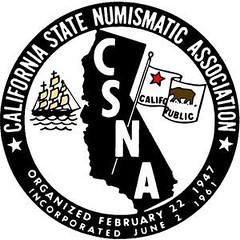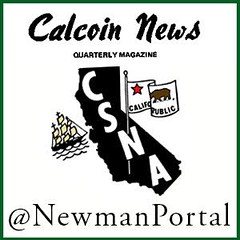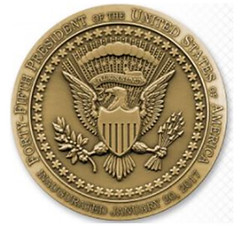
About UsThe Numismatic Bibliomania Society is a non-profit organization devoted to the study and enjoyment of numismatic literature. For more information please see our web site at coinbooks.org SubscriptionsThose wishing to become new E-Sylum subscribers (or wishing to Unsubscribe) can go to the following web page link MembershipThere is a membership application available on the web site Membership Application To join, print the application and return it with your check to the address printed on the application. Print/Digital membership is $40 to addresses in the U.S., and $60 elsewhere. A digital-only membership is available for $25. For those without web access, write to: Terry White, Treasurer AsylumFor Asylum mailing address changes and other membership questions, contact Terry at this email address: terrywhite5475@yahoo.com SubmissionsTo submit items for publication in The E-Sylum, just Reply to this message, or write to the Editor at this address: whomren@gmail.com BUY THE BOOK BEFORE THE COINSale Calendar |
- WAYNE'S WORDS: THE E-SYLUM FEBRUARY 12, 2017
- KOLBE & FANNING FEBRUARY 2017 FIXED PRICE LIST
- BOOK REVIEW: COUNTERFEITING AND TECHNOLOGY
- THE SMITHSONIAN'S ANCIENT GREEK AND ROMAN COINS
- SMITHSONIAN'S RAPID CAPTURE DIGITIZATION
- NEWMAN PORTAL FEATURES SKLOW U.S. MINT POSTCARDS
- 1482 BOOK WARNS ABOUT FAKE NETHERLANDISH COINS
- NOTES FROM E-SYLUM READERS: FEBRUARY 12, 2017
- QUERY: EXTRACTING LAMINATED BANKNOTES
- QUERY: BANKNOTE GRADING, STAMPS AND OVERSTAMPS
- BIBLOPHILE BOGGS TRANSACTIONS
- NEW HARRIET TUBMAN PHOTO DISCOVERED
- BLACK HISTORY IN NUMISMATICS
- VOCABULARY TERM: CUT COINS
- ERNEST HAQUETTE (1845-1911)
- EXHIBIT: BELGIAN MEDALLIST GODEFROID DEVREESE
- NUMISMATIC HOLMES FANS TO MEET IN ORLANDO
- SELECTIONS FROM DAVISSON'S AUCTION 36
- 'BILLY THE KID' FRACTIONAL CURRENCY NOTE OFFERED
- CLEOPATRA'S HAIRSTYLES
- HAIRDRESSING ARCHAEOLOGIST JANET STEPHENS
- BEARDS OF BYZANTIUM
- 1853 TAIWAN MILITARY RATION LOTUS DOLLAR
- DIX NOONAN WEBB SELLING SANDERS WWI MEDALS
- HERITAGE OFFERS OLGA KORBUT'S OLYMPIC MEDALS
- DICK JOHNSON: SO WHERE'S THE INAUGURAL MEDAL?
- EFFIGY MOUNDS QUARTER LAUNCHED IN IOWA
- POLAND ISSUES NEW 500 ZLOTY BANKNOTE
- SO WHY DO PEOPLE WRITE CHECKS FOR GROCERIES?
- FEATURED WEB PAGE: THE US BANKING SYSTEM
Click here to access the complete archive
To comment or submit articles, reply to whomren@gmail.com
Content presented in The E-Sylum is not necessarily researched or independently fact-checked, and views expressed do not necessarily represent those of the Numismatic Bibliomania Society.
WAYNE'S WORDS: THE E-SYLUM FEBRUARY 12, 2017
I've invited a number of new subscribers. Our current total is 2,385. If you're seeing our publication for the first time, we hope you'll enjoy it. Most people find something of interest in every issue. Contact me at whomren@gmail.com anytime regarding your subscription, or questions, comments or suggestions about our content.
Happy Birthday to Abraham Lincoln, Charles Darwin and author Judy Blume. This week we open with a new Kolbe & Fanning fixed price list, one book review, and updates from the Smithsonian and the Newman Numismatic Portal.
Other topics this week include extracting laminated banknotes, black history in numismatics, San Francisco dealer Ernest Haquette, Belgian medallist Godefroid Devreese, cut coins, Olga Korbut's Olympic medals, and why people write checks for groceries.
To learn more about Counterfeiting and Technology , the Washington Temperance Benevolent Society Medal, a new Harriet Tubman photo, the Social War Denarius, Denton's Collectors' Token, Hairdressing Archaeologist Janet Stephens and the most ZZ Top-like of the Byzantine beards, read on. Have a great week, everyone!
Wayne Homren
Editor, The E-Sylum
KOLBE & FANNING FEBRUARY 2017 FIXED PRICE LIST
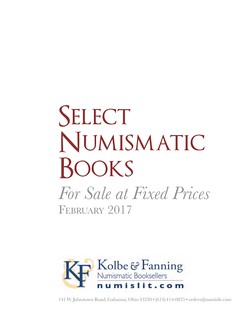 Kolbe & Fanning are pleased to announce the availability of their February fixed-price catalogue, featuring rare and out-of-print numismatic books from around the world. Including works on
ancient, medieval and modern topics, the 36-lot PDF catalogue offers a wide variety of material. To download the catalogue, visit our website at numislit.com.
Kolbe & Fanning are pleased to announce the availability of their February fixed-price catalogue, featuring rare and out-of-print numismatic books from around the world. Including works on
ancient, medieval and modern topics, the 36-lot PDF catalogue offers a wide variety of material. To download the catalogue, visit our website at numislit.com.
A few highlights from this offering include:
- a copy of the catalogue of the collection of Charlotte Sophie of Aldenburg, Comtesse Bentinck, presented to her granddaughter
- a first edition set of Crawford’s Roman Republican Coins
- the very rare 1821 printing of James Mease’s article on early American medals, the first substantive numismatic work published in the United States
- W. Elliot Woodward’s rare work on Washington memorial medals, one of ten copies printed in quarto on English drawing paper.
The catalogue is being published only in PDF form. No printed catalogue will be issued. It is being distributed first to those customers of ours who have signed up for our email list. You can sign up for our mailing list on our website at numislit.com. Kolbe & Fanning plan to issue similar fixed-price PDF catalogues in the future, so make sure you are among the first to know of them: most items offered are one of a kind.
Please email David Fanning at orders@numislit.com or call our office at (614) 414-0855 to purchase lots. We look forward to hearing from you.
To download the catalogue, see:
https://www.numislit.com/dl.php?file=/images/upload/kolbefanning0217fpl.pdf&type=pdf

BOOK REVIEW: COUNTERFEITING AND TECHNOLOGY
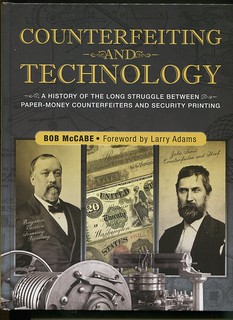 Counterfeiting and Technology
Counterfeiting and Technology
A history of the long struggle between paper-money counterfeiters and security printing
by Bob McCabe
$39.95
Whitman Publishing
This book is destined to be the best numismatic publication of the year. It carries a copyright date of 2016, but became available in 2017.
I’m simply advising that if you are even remotely interested in the topic, buy it. There is nothing cheaper in our game than information, and this 480-page treatise, which weighs in at something over 4 pounds, is bristling with sound, engagingly presented information.
McCabe, a chemist by profession, walks you through the who’s-who of American counterfeiters and the tales of their fascinating personal odysseys from the inception of paper money in the Colonies to the end of the large-size note era. OK, this is what you expect in a book with this title, and that job is done superbly.
Equally covered and particularly valuable is a comprehensive development of the bank note printing trade and the evolution of technologies used by it to produce notes. McCabe explains all the technologies and machines – including ink development and manufacture – in terms and with illustrations that bring the topic to life. This material is presented with technical accuracy but doesn’t overshoot a non-technical audience.
He draws out the interplay and competition between the bank note companies and the Bureau of Engraving and Printing as they vied for Treasury contracts to produce U. S. currency. These types of discussions are insightful and balanced, and you get to meet the personalities who made it all happen and gain an understanding of why in the historical context of the times things came out as they did.
Like I said, this is a 4-pounder, the reason being that it was printed on high-gloss paper in an 8-1/2 x 11-inch format because one object of both the author and publisher was to be certain that the lavish and prolific illustrations came out well. Were the illustrations of the currency the right size, you could cut them out and spend them they are so well done.
You are not going to sit down and polish this off in a couple of evenings. It is going to be a work you go back and forth to like an encyclopedia, bible or some other important reference work. If you are like me, you are going to skip around it and consume it in bite-size pieces.
There are some bonuses that made it particularly useful. It has an excellent index so you can navigate it. It has 27 pages of fine-print references to literature that he drew from. It has a 14-page glossary. It has copious endnotes so you find your way to his source materials. This guy dug deeply and traveled all over for decades to compile this book.
It has 11 appendicles, some being verbatim transcriptions of pivotal early manuscripts pertaining to the development of the bank note trade. One appendix that I found especially useful is a comprehensive listing of the principal U. S. patents awarded for technologies and processes that advanced the art and industry of bank note printing.
Most of you know me as something of a currency and stamp printing technology junkie and this work really is satisfying on that score. But don’t be put off by my biases because if all you want is to read are detailed accounts of the bad guys and the cops and robbers part of the story, you will have more of that than you ever imagined, and all of that will be set in a larger historic and technological context.
For more information, or to order, see:
Counterfeiting and
Technology: A History of the Long Struggle Between Counterfeiters and Security Printing
(www.whitman.com/store/Inventory/Detail/Counterfeiting-and-Technology-A-History-of-the-Long-Struggle-Between-Counterfeiters-and-Security-Printing+0794843956)
To read the earlier E-Sylum articles, see:
NEW BOOK: COUNTERFEITING AND TECHNOLOGY (www.coinbooks.org/esylum_v19n02a05.html)
NEW BOOK: COUNTERFEITING AND TECHNOLOGY (www.coinbooks.org/esylum_v19n29a03.html)
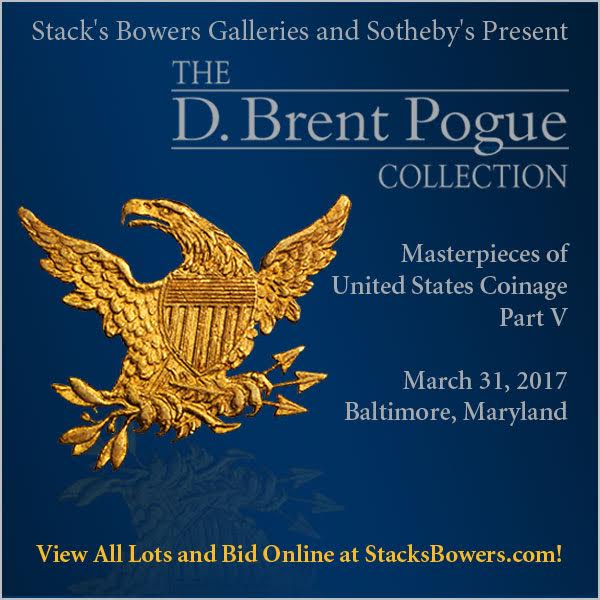
THE SMITHSONIAN'S ANCIENT GREEK AND ROMAN COINS
The Smithsonian’s National Numismatic Collection holds approximately 26,900 Greek and Roman coins and has good representation in all areas of ancient coinage. A group of scholars recently carried out an assessment that revealed some exceptional strengths of the collection, including world-class holdings of eastern Roman provincial and civic coin issues and a number of older hoards. A narrative overview of the assessment and listing of the coins is now available on the National Numismatic Collection’s website (http://americanhistory.si.edu/national-numismatic-collection/collection). Anyone with an interest in consulting any of these coins is invited to email Ellen Feingold, curator of the National Numismatic Collection, at FeingoldE@si.edu or Jennifer Gloede, Outreach and Collections Specialist, at GloedeJ@si.edu.
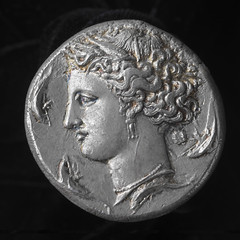 An assessment of these coins was performed over the course of three days in late October and early November, 2016 by Christian Cloke (Smithsonian Intern), Andrew Burnett (Former Deputy
Directory, British Museum), Emily Pearce Seigerman (Museum Specialist), and Jennifer Gloede (Outreach and Collections Specialist). This exercise was conducted quite rapidly, and while some coins were
likely misidentified or miscounted, it has also resulted in the first holistic record of this part of the collection. This assessment has revealed some exceptional strengths of the collection,
including world-class holdings of eastern Roman provincial and civic coin issues and a number of older hoards, the study of which may contribute much to our understanding of the chronology of ancient
coinage and economic history. A fuller record of this assessment can be found in an excel file listing Greek coins in one table and Roman in another, available on the website of the National
Numismatic Collection
An assessment of these coins was performed over the course of three days in late October and early November, 2016 by Christian Cloke (Smithsonian Intern), Andrew Burnett (Former Deputy
Directory, British Museum), Emily Pearce Seigerman (Museum Specialist), and Jennifer Gloede (Outreach and Collections Specialist). This exercise was conducted quite rapidly, and while some coins were
likely misidentified or miscounted, it has also resulted in the first holistic record of this part of the collection. This assessment has revealed some exceptional strengths of the collection,
including world-class holdings of eastern Roman provincial and civic coin issues and a number of older hoards, the study of which may contribute much to our understanding of the chronology of ancient
coinage and economic history. A fuller record of this assessment can be found in an excel file listing Greek coins in one table and Roman in another, available on the website of the National
Numismatic Collection
The collection has a good representation of all areas of ancient coinage, totalling 26,972 pieces (far more than the 12,000–13,000 pieces it was estimated to contain prior to this assessment)
Although there are many pieces of Greek gold and silver, the collection is mostly of bronze coinage. The silver especially includes a number of forgeries and copies, often electrotypes, and it may be that more such pieces would be identified after a more careful study than was possible in this exercise. Non-genuine coins of one type or another include some ancient forgeries, as well as a range of early modern and modern copies, both those that were made with the intent to deceive and others made to serve as inexpensive copies of rare or remarkable pieces. This subset of the collection is perhaps interesting in its own right, and a more careful reckoning of the types and number of forgeries and copies would be worthwhile.
The Greek coinage, which includes pieces from throughout the ancient Mediterranean world, displayed several areas of considerable strength. One well-represented region was southern Italy and Sicily; in the collection of pieces from these areas were many silver tetradrachms of Messana (famous for being the site of the first major conflict between Rome and Carthage at the start of the First Punic War), and coins of Syracuse, possibly from a hoard.
An unexpected strength was the very extensive holdings of Greek city coinage, especially of the Roman imperial period, from the north-eastern Balkans, for example mints in Moesia and Thrace (numbering approximately 2,000 specimens). In the latter region, the mint of Hadrianopolis was represented by 61 bronze Roman imperial coins, possibly from a hoard. Many silver coins of Dyrrhachium (Durres in present-day Albania) may also constitute the remains of an ancient hoard.
Among the strengths of the Roman collection is a good series of gold aurei: nearly every emperor, even those who ruled quite briefly and whose coins are thus very rare, is represented by at least one or two specimens. The Roman material also includes at least two hoard groups: the earlier is a group of sestertii of the 3rd century AD, down to Gallienus in the 260s (with coins of the emperors Severus Alexander, Gordian III, and Philip present in large numbers); the second is the ‘Rosen Hoard’ (currently being prepared for publication by Cloke) of nearly 600 bronze nummi of the tetrarchic period, with an end date circa AD 312/313. Each of these large groups likely merits further study and publication.
There is a reasonable collection of Roman Republican coins, mostly silver, which are arranged following Sydenham’s catalogue, The Coinage of the Roman Republic. Parallel to the representative sample of imperial Roman issues are a vast quantity of provincial issues of the Greek east, housed in the Greek coin cabinets (see the above discussion of Greek coins of the Balkans and modern Turkey). Also notable among these, in addition to the aforementioned regional groups, is a sizeable lot of bronze and debased silver issues from Egypt, which span the entirety of the principate and constitute a significant subset of Roman provincial coinage in the collection.
To read the complete narrative, see:
SMITHSONIAN NATIONAL NUMISMATIC COLLECTION
Overview of ancient Greek and Roman coins
December 13, 2016 (https://americanhistory.si.edu/sites/default/files/file-uploader/Overview.pdf)
For more information on the National Numismatic Collection, or to search the catalog, see:
The Collection (http://americanhistory.si.edu/national-numismatic-collection/collection)
SMITHSONIAN'S RAPID CAPTURE DIGITIZATION
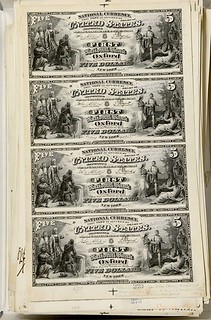 In the age of credit cards, Bitcoin and mobile payments, it's hard to believe that the proofs once used to create paper money can be as significant as priceless works of art. In the
19th and early 20th centuries, American states issued their own bank notes, made from metal plates engraved by hand. For immigrants at the time, the money in their pockets meant more than just
opportunity; the scenes printed on them, such as Benjamin Franklin flying his famous kite, taught them about American history.
In the age of credit cards, Bitcoin and mobile payments, it's hard to believe that the proofs once used to create paper money can be as significant as priceless works of art. In the
19th and early 20th centuries, American states issued their own bank notes, made from metal plates engraved by hand. For immigrants at the time, the money in their pockets meant more than just
opportunity; the scenes printed on them, such as Benjamin Franklin flying his famous kite, taught them about American history.
As the Smithsonian works to digitize its collection of 137 million items, the Digitization Program Office has turned to the National Numismatic Collection housed at the Smithsonian's National Museum of American History along with other legal tender such as bank notes, tax stamps and war bonds. The 250,000 pieces of paper will become the Institution’s first full-production “rapid capture” digitization project.
The project team, made up of 20 people hailing from a handful of departments across the Institution, began its pilot effort last February and moved forward in October, around Columbus Day. That’s fitting, because some of the proofs depict Columbus discovering America. “This is a lost art form,” says Jennifer Locke Jones, chair and curator of the Division of Armed Forces History. (Even Jones admits she no longer carries cash.)
Last summer, the Digitization Office captured the bumblebees at the National Museum of Natural History. Earlier this month, the Freer and Sackler galleries made their entire collections of 40,000 works available digitally, the first Smithsonian museums to do so.
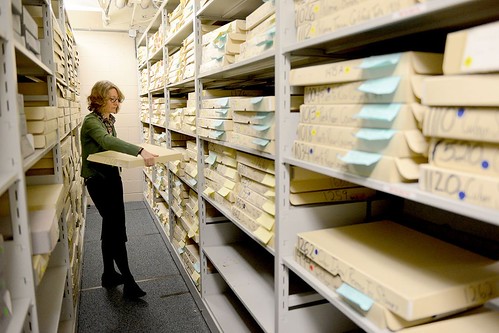
The term “rapid capture” refers to the speed of the workflow. Before this process was in place, digitizing a single sheet could take as much as 15 minutes, at a cost of $10 per sheet. Now, the team works through 3,500 sheets a day, at less than $1 per sheet.
The process uses a conveyor belt and a custom-designed 80 megapixel imaging system, making details available to the world that had only ever been seen by a select few. (By contrast, the new iPhone camera has only eight megapixels.) The conveyor belt resembles the ones used by security at airports. Markings on the belt guide team members in placing the sheets. The belt advances when the sheet at the end has been removed. Such equipment has never before been used in the United States.
Before such state of the art technology, digitizing that daily amount would have taken years, says Ken Rahaim, the Smithsonian's digitization program officer. “Prior to this,” Rahaim says, “nobody ever thought in terms of seconds per objects.”
Rahaim says the project is on schedule to conclude in March. Transcribing the information from the sheets into the online system must be done sheet by sheet, and will continue after digitizing has wrapped. The Institution has asked the public to help transcribe through its Smithsonian Transcription Center. For this project, transcribers have completed 6,561 pages, each with information about what bank and city the sheet is from, what date the original plate was made, and other numismatic details.
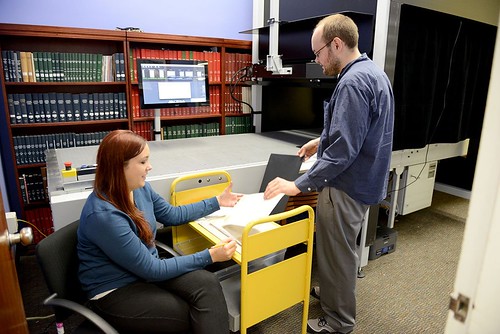
Aside from the occasional sheets stuck together, which causes a few seconds of delay, things have moved smoothly. “There’s a large element of human checking that still needs to happen at every point in the process,” Jones says.
“We have unlocked the ability to do this efficiently and at a price that was unheard of before,” Rahaim adds. “Digitizing a whole collection, it was an abstract concept, but these processes are now making that a reality.”
To read the complete article, see:
Museums Are Now Able to Digitize Thousands of Artifacts in Just
Hours (www.smithsonianmag.com/smithsonian-institution/museums-are-now-able-digitize-thousands-artifacts-just-hours-180953867/)
To read the earlier E-Sylum articles, see:
SMITHSONIAN DIGITIZING 250,000 BEP PROOFS (www.coinbooks.org/esylum_v18n16a12.html)
SMITHSONIAN DIGITIZES 270,000 BEP CERTIFIED PROOFS (www.coinbooks.org/esylum_v18n48a05.html)
HOW THE SMITHSONIAN IS CROWDSOURCING HISTORY (www.coinbooks.org/esylum_v19n07a07.html)

NEWMAN PORTAL FEATURES SKLOW U.S. MINT POSTCARDS
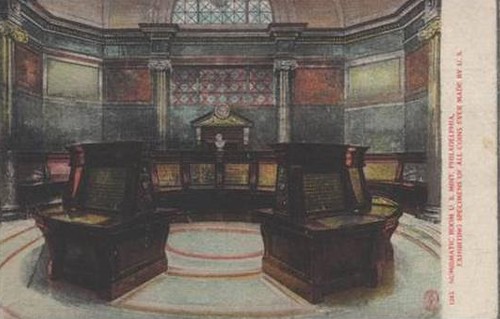
For many years David Sklow has been collecting postcards depicting the Philadelphia Mint, and these can now be viewed on the Newman Portal. This is the essence of collecting – diligently searching over a long period of time for items that aren’t necessarily expensive, but devilishly difficult to locate. One senses in this collection a great deal of time thumbing through postcards for sale, as well as endless surfing of Internet sites.
The collection also reveals a bit of postcard history – the greatest number of examples relate to the third Philadelphia Mint at Spring Garden and 17th Streets, built in 1901 and in service until 1969. The early 20th century represents the perfect storm of numismatics and deltiology – ubiquitous commercial postcard production combined with a new Mint building that sumptuously featured the Mint Cabinet until the 1920s, when it was moved to the Smithsonian. Thousands of souvenir-hungry visitors passed through the Mint in this period, and the postcard vendors were all too happy to satisfy the demand.
Link to the Sklow Collection on NNP:
https://nnp.wustl.edu/library/book/526626
1482 BOOK WARNS ABOUT FAKE NETHERLANDISH COINS
Eric Vanhove writes:
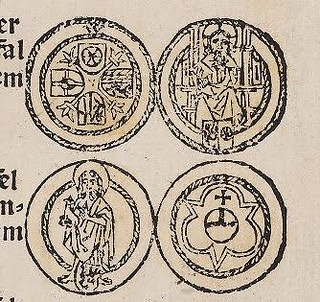 I follow a guy on Twitter who posts pictures from medieval manuscripts, and today he posted pics from a page from 1482 that had warnings about fake Netherlandish coins. I've attached
the pictures, which are from a manuscript at the Bodleian (Bodleian oulis2009-btj0049). The pictures are what the coins are supposed to look like.
I follow a guy on Twitter who posts pictures from medieval manuscripts, and today he posted pics from a page from 1482 that had warnings about fake Netherlandish coins. I've attached
the pictures, which are from a manuscript at the Bodleian (Bodleian oulis2009-btj0049). The pictures are what the coins are supposed to look like.
I don't know anything about Netherlandish coins, but thought it might be of interest to those that do.
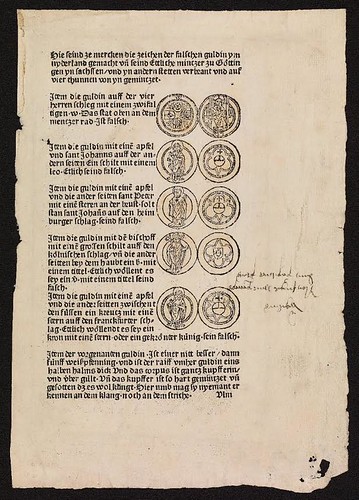
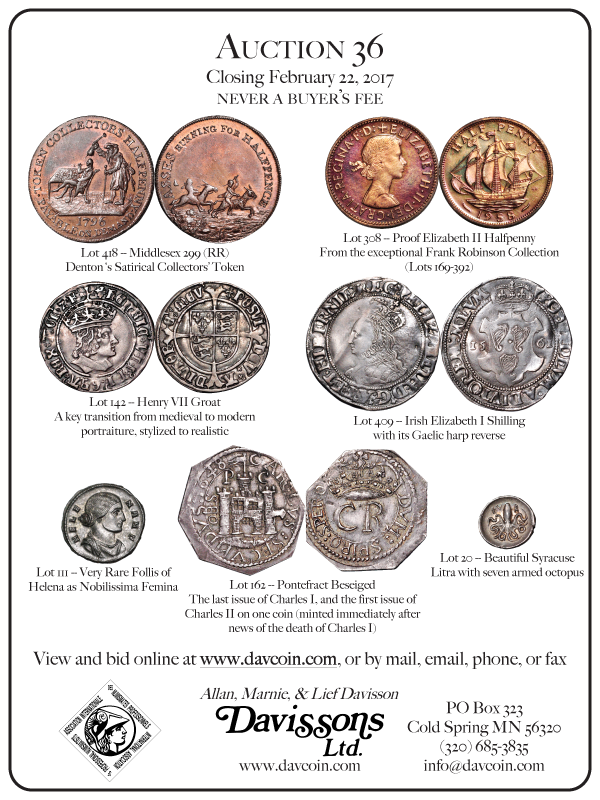
NOTES FROM E-SYLUM READERS: FEBRUARY 12, 2017
Laban Heath's Grave
Speaking of counterfeit detecting, Numismatic bibliophiles know Laban Heath as the prolific publisher of countless 19th century paper money counterfeit detector books. Pete Smith writes:
While researching revisions to my book American Numismatic Biographies, I came across photos of the memorial to Laban Heath at Evergreen Cemetery at Kennebunk, Maine. I thought it was impressive.
I frequently use the "Find A Grave" site in my research. It is not just good to find a grave location. If I know the name of someone and the city where they lived, I can often use "Find A Grave" to learn dates of birth and death. In the case of Heath, it also provides an extensive obituary.
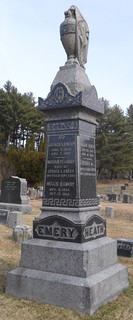
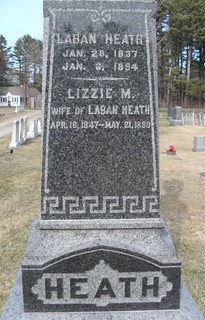
Query: Washington Temperance Benevolent Society Medal
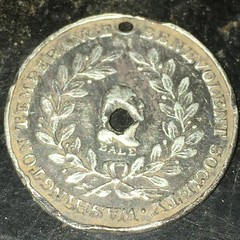
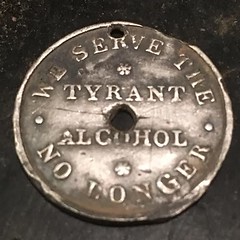
Web site visitor Charles Reina writes:
I recently came across a George Washington Temperance Benevolent Society medal. It's a silver piece with Washington and the laurel wreath on one side with the words We Serve the Tyrant Alcohol No Longer on the other. Any info on this medal would be helpful as I can find little online. Thank you.
I found this listed on p158 of the 2nd edition of Rulau's Medallic Portraits of Washington (#333) and on p236 of Neil Musante's new Medallic Washington, where it is given #GW-164 with the note, "This is an extremely rare variety. Possibly other die varieties exist, as the medal was distributed for several years, and it would not be surprising if more were to surface." The die were created by James Bale.
Reader thoughts are welcome. It is common for such pieces to be holed, as they were typically worn as a badge. This one's seen a lot of wear, but is an interesting and rare piece. -Editor
Neil Musante writes:
I think this is like the third example of this variety that I have seen. The problem with this one obviously, is the condition. It was probably struck circa 1840 to 1841 as the temperance movement began to gain traction in the US. The bust punch of Washington is the same as the one used on the Par Nobile Fratrum medalet (GW-142 Washington & Lafayertte), which was struck while Bale was still in partnership with C.C. Wright. This leaves room for the possibility, probability? that the Washington bust was actually cut by Wright.
More on the Internet and Numismatics
Chris Bower writes:
I just wanted to comment on Joel Orosz's article "ON THE INTERNET AND NUMISMATICS" from the last issue of The E-sylum. I know from personal experience that I would not be nearly as involved in numismatics today if not for the internet. Taking the typical path I was pretty much out of the hobby for 20+ years because of family priorities. Now in my 40's I have jumped back in with both feet.
Having recently moved to Indianapolis I joined my first actual coin club, "Indianapolis Coin Club". How did I find them? The internet of course. Going to local coin shops I asked about clubs and was given vague, useless information on local clubs. At least they could tell me there was a monthly coin show in town. So I googled coin clubs and there was all the information I needed.
I have attended a number of auctions because of the information found online. This past summer I attended the ANA World's Fair of Money in large part because there were some coins that were listed by one of the large auction houses that I want to "see" before I bid. It's a good thing I did. No matter how well the pictures are done they always look different in person. My whole strategy changed after actually viewing the items. This would have never happened without the internet.
I use the websites of most of the larger numismatic book sellers and make a point of purchasing from them. My knowledge isn't where I want it to be. I need them to tell me what literature is out there on my collecting specialties. Digital copies of any research material aren't for me. I insist on hard copies, preferably originals.
The internet has actually made me a more social numismatist. I attend more shows, meetings and auctions than I never did before simply because the information about them is more easily accessible on line than anywhere else.
To read the earlier E-Sylum article, see:
ON THE INTERNET AND NUMISMATICS (www.coinbooks.org/v20/esylum_v20n06a13.html)
More On The First 1794 Dollars
Alan Meghrig writes:
There is a retelling of the travels within the Philadelphia mint of the deposited Silver for the 1794 dollar thru its dispensing to the silver depositor. See the Jack Collins/ Walter Breen, book on 1794 dollars. The information is from a microfilm of a Mint ledger in the National archives.
To read the earlier E-Sylum article, see:
NOTES FROM E-SYLUM READERS: FEBRUARY 5, 2017 : First 1794 Dollar Article Updated (www.coinbooks.org/v20/esylum_v20n06a11.html)
William Weimer
Web site visitor Raven Sinclaire writes:
I recently found a post on your website where someone asked about William Weimer. I know Bill quite well and was friends with him and his wife, Julie. Julie died last year and Bill has terminal cancer. I see him about every two weeks for lunch. He still gets around well, but doesn't drive. I pick him up from a retirement community that he moved into with Julie a few years ago. He has already outlived the longest date that his doctor gave him and doesn't seem any worse. He is such a great guy.
To read the earlier E-Sylum articles, see:
NOTES FROM E-SYLUM READERS: SEPTEMBER 14, 2014 : Query: William Weimer Information Sought (www.coinbooks.org/esylum_v17n38a09.html)
WILLIAM WEIMER (www.coinbooks.org/esylum_v17n39a25.html)
Whitman Coin Folders in the 1950s
Gawain O'Connor writes:
When doing some other research, I found this on one of the Internet photo archives. It shows a group of blue Whitman folders in the background and possibly an unnamed coin book.
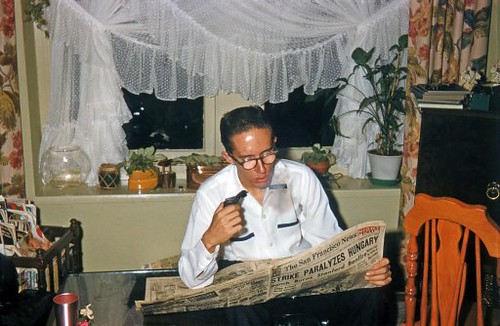
David Lange writes:
I've followed Shorpy daily for years, and I saw that photo when it was published. The folders are likely from the Third Series (1953-59) within Whitman's Second Edition (1942-59).
To read the complete article, see:
And Now the News: 1956 (www.shorpy.com/node/4697)
Query: Coin Galleries September 2008 Sought
Larry Korchnak writes:
I have an inquiry regarding a siege coin that I purchased some time ago. The tag indicates that it is from the Coin Galleries (Stack's) Lot 1185 mail/internet bid sale of September 2008. Can anyone provide the lot description from that sale for me? I would appreciate a scan or the text in any form.
Definition: Nimbate
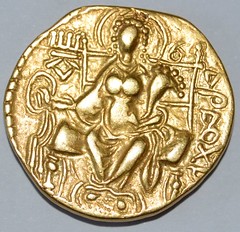 This is an art historical term for haloed figure in art, hence, nimbate, i.e., a figure such as a saint, or emperor with a halo or nimbus. From the Latin, nimbus (singular), or nimbum
(plural) cloud or clouds, generally storm or rain clouds, as in stratus-nimbus clouds; but also in the transfigurative sense means a head-band or frontlet, which became transferred diachronically to
mean a halo of light or glory surrounding the head of a deity or saint signifying divinity and sacredness. In art typically rendered in gold, hence also called aureole, which by the way is taken from
Ol French or Anglo-Norman. The Italian for this form is mandorla, but coming from the word for "almond" refers to the almond-shaped glory surrounding not just the head but the whole body.
The Greek is φωτοστέφανος, a compund noun comprising "photo(s)" = light and "stephanos" a crown, hence a crown of light
or glory = halo or nimbus.
This is an art historical term for haloed figure in art, hence, nimbate, i.e., a figure such as a saint, or emperor with a halo or nimbus. From the Latin, nimbus (singular), or nimbum
(plural) cloud or clouds, generally storm or rain clouds, as in stratus-nimbus clouds; but also in the transfigurative sense means a head-band or frontlet, which became transferred diachronically to
mean a halo of light or glory surrounding the head of a deity or saint signifying divinity and sacredness. In art typically rendered in gold, hence also called aureole, which by the way is taken from
Ol French or Anglo-Norman. The Italian for this form is mandorla, but coming from the word for "almond" refers to the almond-shaped glory surrounding not just the head but the whole body.
The Greek is φωτοστέφανος, a compund noun comprising "photo(s)" = light and "stephanos" a crown, hence a crown of light
or glory = halo or nimbus.
To read the earlier E-Sylum article, see:
NUMISMATIC NUGGETS: FEBRUARY 5, 2017 : India Kushan Empire Gold Dinar (www.coinbooks.org/v20/esylum_v20n06a25.html)
Frank Lapa Death Date
Paul Schultz writes:
There are four Frank Lapas in the Social Security Death Index. If someone knows his age or birth date, it should be easy to pick him out,
Pete Smith writes:
Newspaper accounts report that Frank Albert Lapa was 44 in 1975 and 45 in 1976. I believe he was born October 24, 1931 and died August 28, 1995.
To read the earlier E-Sylum article, see:
NOTES FROM E-SYLUM READERS: FEBRUARY 5, 2017 : Frank Lapa Question (www.coinbooks.org/v20/esylum_v20n06a11.html)

QUERY: EXTRACTING LAMINATED BANKNOTES
Kavan Ratnatunga of Sri Lanka writes:
After reading about coins in Lucite I wanted to ask a question I found had been asked over 10 years ago about removing a "bank note from a heat-applied plasticized tomb, such as you would use on a driver's license or ID card". Did you ever find an answer ? Not sure I want to try.
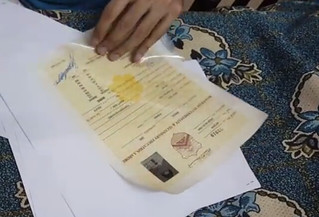 To watch a YouTube video on lamination extraction, see:
To watch a YouTube video on lamination extraction, see:
How to delaminate any document the safe way (https://www.youtube.com/watch?v=CVJx45xiXZg)
To visit the Spandan Delamination Service site, see:
http://www.howtoremovelamination.com/
To read an article against laminating in the first place, see:
Do not laminate your notes! (http://sgbanknotes.blogspot.com/2010/05/do-not-laminate-your-notes.html)
To read the earlier E-Sylum article, see:
NOTES FROM E-SYLUM READERS: FEBRUARY 5, 2017 : Extracting Coins Embedded in Acryllic (www.coinbooks.org/v20/esylum_v20n06a11.html)
QUERY: BANKNOTE GRADING, STAMPS AND OVERSTAMPS
On a related topic, Kavan Ratnatunga writes:
I assume if a laminated currency note was sent for grading it will be returned as unable to grade as mutilated. But I was amazed to find recently on sale on eBay attached PMG 64 certified US$2 note which had a UN and a US postage stamp affixed with ink cancellations.
I don't understand the grading logic - isn't this also a mutilated currency note? The question I have is how a mutilated currency note can be Uncirculated.
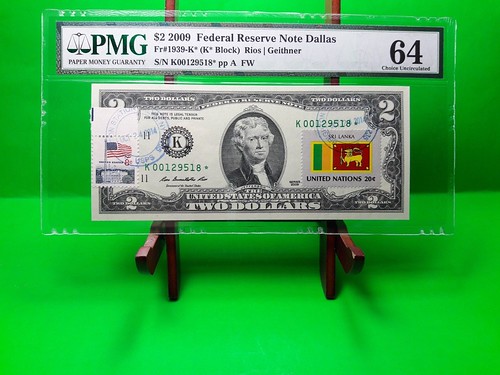
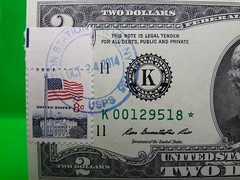
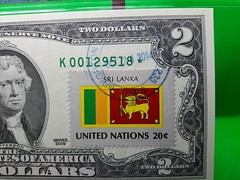
Kavan adds:
I have even found red faded on front maybe washed clearly dirty and VF condition at back that have been certified as PMG AU50. it seems grading is just a commercial enterprise not supporting numismatics but auctions to the gullible.

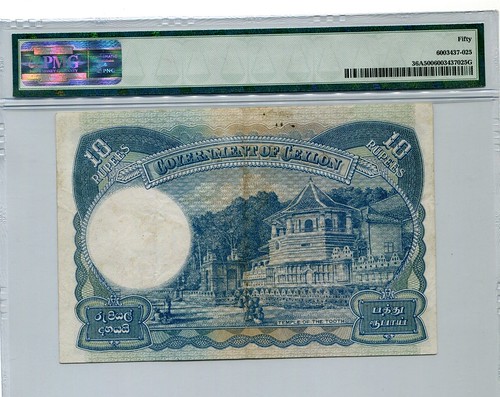

BIBLOPHILE BOGGS TRANSACTIONS
Pete Smith writes:
Boggs was at the 1994 ANA convention in Detroit. As I recall he was selling his signature for $1.00 or his autograph for $10.00. I gave him a dollar for his signature on a 4 x 6 card.
After some discussion, we completed a transaction. I gave him a copy of my book, Building, Maintaining and Disposing of a Numismatic Library. He recorded the transaction on another 4 x 6 card with his autograph.
I believe I have the only record of a Boggs transaction involving a piece of numismatic literature written about numismatic literature.
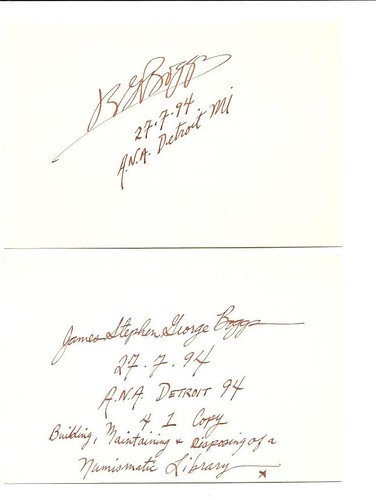
To read the earlier E-Sylum articles, see:
J.S.G. BOGGS (1955-2017) (www.coinbooks.org/v20/esylum_v20n05a04.html)
MORE ON MONEY ARTIST J.S.G. BOGGS (www.coinbooks.org/v20/esylum_v20n06a16.html)
NEW HARRIET TUBMAN PHOTO DISCOVERED
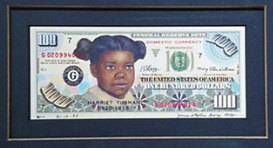
Last last year the U.S. Treasury announced plans to place her portrait on the $20 bill. Time will tell if the new administration will follow through on those plans, but if B.E.P. artists are looking for an image to base her portrait on, a good candidate may have just been found.
Sometimes the only existing portrait of an historical figure is one from their old age, as until recently was the case with Tubman. This mockup pairs the note with a portrait of Tubman taken in her old age. What follows is an excerpt from an article about the new photo's discovery. -Editor
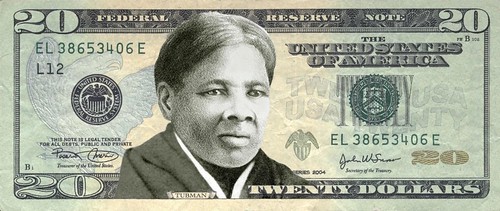
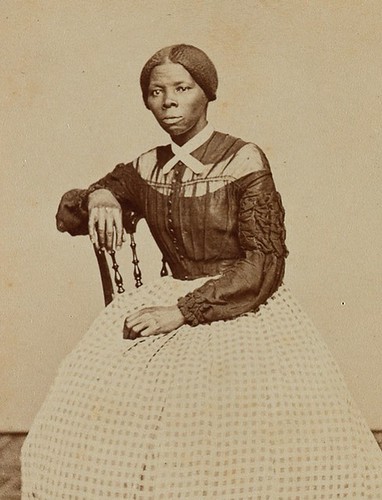 In the photo, Harriet Tubman is still relatively young, perhaps in her early or mid-forties. She would live into her 90s, and many of the photos of her show her as an older woman. In this
photo, which sat unknown in a photo album for decades, Tubman is in her prime, perhaps enjoying the respite from her work guiding slaves to freedom.
In the photo, Harriet Tubman is still relatively young, perhaps in her early or mid-forties. She would live into her 90s, and many of the photos of her show her as an older woman. In this
photo, which sat unknown in a photo album for decades, Tubman is in her prime, perhaps enjoying the respite from her work guiding slaves to freedom.
“This is the vibrant young Tubman just coming off her work during the Civil War. She’s building her life with her family in Auburn,” Kate Clifford Larson, a Tubman biographer, told The Citizen, a paper based in Auburn, New York.
Before the Civil War began, Tubman bought a piece of land in Auburn. The photo was found in a photo album that once belonged to Emily Howland, an abolitionist and friend of Tubman.
The photo is being auctioned as part of an album by New York City’s Swann Galleries in March, along with checks signed by Martin Luther King, Jr., and a speech by Frederick Douglass. According to the auction house, the photo was discovered by one of their specialists; the album includes images of other abolitionists and 19th century political figures.
To read the complete article, see:
Found: A Long-Lost Photo of Harriet Tubman
(www.atlasobscura.com/articles/found-a-longlost-photo-of-harriet-tubman)
To read the earlier E-Sylum articles, see:
HARRIET TUBMAN RECOMMENDED FOR THE U.S $20 NOTE (www.coinbooks.org/esylum_v18n20a15.html)
CONSIDERING THE CONTROVERSIAL J.S.G. BOGGS (www.coinbooks.org/esylum_v19n34a18.html)
THE BOOK BAZARRE
BLACK HISTORY IN NUMISMATICS
Len Augsburger writes:
John Kraljevich is doing a a fabulous Facebook series on Black History Month, featuring one related numismatic item per day.
February 1: General Benjamin Butler Colored Troops Medal
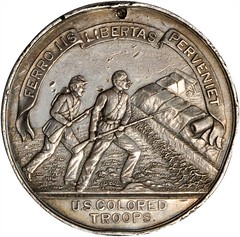
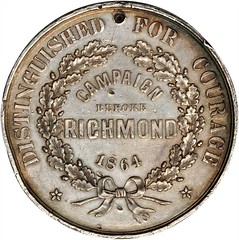
In the case of the men who earned this medal in 1864, the fight for freedom was a very literal fight for freedom.
As someone who buys and sells historic objects all day every day, it's easy to get jaded. Every once in awhile, something comes along to help you snap out of it. In 1865, Union General Benjamin Butler paid out of his own pocket for a medal to be struck to honor the courage of the men of the U.S. Colored Troops who fought under him on the way to Richmond.
"These I gave with my own hand, save where the recipient was in a distant hospital wounded, and by the commander of the colored corps after it was removed from my command, and I record with pride that in that single action there were so many deserving that it called for a presentation of nearly two hundred."
197 medals were struck in silver, most awarded to those who fought. This one actually bears the recipients name on the edge: Abraham Armstead. He was a slave in eastern NC until he got to Union lines and signed up at age 43. Six weeks later, he was the sergeant of his company. Imagine Morgan Freeman in Glory, but real. The medal is inscribed in Latin "Ferro iis libertas perveniet" or "Liberty will be theirs by the sword." Every other one of these I've seen is in nearly perfect condition, laid in a drawer one day in 1865 and forgotten about. It looks like Sergeant Armstead wore this one day in and day out for years. Nobody knows the trouble it's seen.
To read the complete post, see: www.facebook.com/john.kraljevich/posts/10212201821740560
February 5: Minstrelry
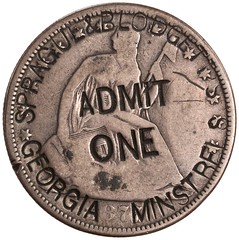 The post-Civil War popularity of minstrelsy has inspired a great deal of modern historical discussion. The minstrel companies of the 1870s and 1880s saw a rise in both African-American
performers and audiences, a byproduct of limited outlets for both decent employment in the arts for Northern blacks and public performances that were open to them.
The post-Civil War popularity of minstrelsy has inspired a great deal of modern historical discussion. The minstrel companies of the 1870s and 1880s saw a rise in both African-American
performers and audiences, a byproduct of limited outlets for both decent employment in the arts for Northern blacks and public performances that were open to them.
Brooker and Clayton’s Georgia Minstrels are thought to have been the first all-black troupe, founded just after the end of the Civil War. Following their lead, other troupes used the words “Georgia Minstrels” to advertise that their performers were actual African-Americans instead of whites in blackface.
This 1877-dated half dollar served as both an advertisement and admission ticket for Sprague and Blodgett’s Georgia Minstrels, which was managed by Charles B. Hicks, the African-American founder of the Brooker and Clayton Georgia Minstrel troupe a decade earlier. According to Matthew Wittman, now the curator of the theatre collection at Harvard’s Houghton Library, “by June 1878 [Blodgett’s] name was dropped from the advertising. The countermarked coins associated with Sprague & Blodgett were thus produced sometime between the fall of 1876 and the spring of 1878.” The illustrated piece is the one in the American Numismatic Society collection. I have a similar one in my own collection, one of perhaps a dozen or two extant.
To read the complete post, see: www.facebook.com/john.kraljevich/posts/10212239815810388
February 9: St. Vincent Black Corps
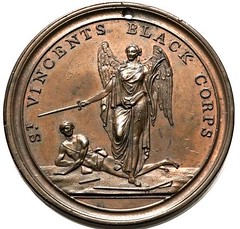
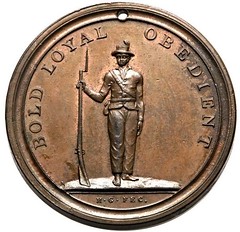
Perhaps the most notable example of pitting the enslaved against Native Americans took place on the West Indian island of Saint Vincent during the Second Carib War of the mid 1790s. The Caribs (for whom the Caribbean was named) were a synthetic tribe formed by the various indigenous peoples who had not died out in the violence and plagues in the decades following Columbus’ arrival. By the 18th century, the Caribs were called “Black Caribs,” a people whose heritage was a mix of the island's indigenous residents and former slaves that either escaped to their communities or were shipwrecked. An uprising of the Caribs in the 1770s was put down by the British military forces on Saint Vincent, but another followed in the 1790s, inspired by the uprising that had created the nation of Haiti.
Intent on putting down the second uprising, the British military establishment raised two regiments of men who had been recently enslaved: some were purchased and freed to make them soldiers, some were promised their freedom if they fought. Termed the Saint Vincent Black Corps, these men of African heritage were placed alongside British regulars and local militias to fight against other men of African heritage, the Black Caribs. Those who fought under the British flag were free men thereafter. Those men and their officers were granted a military decoration that depicted a black solder with the three words the British military thought best summarized their new troops: BOLD, LOYAL, OBEDIENT
The Black Caribs were defeated and sent in exile to Honduras, where their descendants are today known as the Garifuna, culturally distinct and speaking a language similar to the one Columbus heard when he first landed in the West Indies in 1492.
To read the complete post, see:
www.facebook.com/john.kraljevich/posts/10212280651831263
February 10: Birth of A Nation Lincoln Plaque
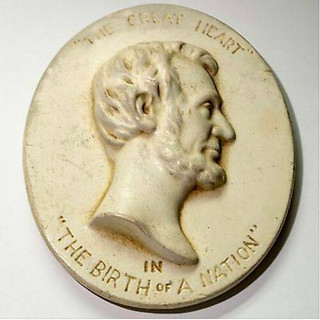 I write tonight from Los Angeles, where I sit in a hotel that was once the home of Lillian Gish, the heroine of the 1915 film Birth of a Nation. Inarguably one of the most racist American
movies ever made, the story of the upheaval against Birth of a Nation is a chapter of African-American history too little known (but recently covered in an excellent documentary called "Birth of
a Movement," shown on PBS).
I write tonight from Los Angeles, where I sit in a hotel that was once the home of Lillian Gish, the heroine of the 1915 film Birth of a Nation. Inarguably one of the most racist American
movies ever made, the story of the upheaval against Birth of a Nation is a chapter of African-American history too little known (but recently covered in an excellent documentary called "Birth of
a Movement," shown on PBS).
The film was largely inspired by a novel and play called The Clansman, which is a better summation of its plot line than the title given to the screen adaptation. Its storyline adapted the historical events at the end of the Civil War with a grossly fictionalized view of Reconstruction that better fit the Lost Cause ideology then popular than any historical reality. Its caricatures of African-Americans not only dramatized the worst derogatory stereotypes of the era, but made plain that the only way to combat the lustful and thieving nature of the black underclass was with violence.
The year Birth of a Nation appeared in theatres, 56 African-Americans were lynched.
The film’s racial violence did not go unnoticed or unchallenged in the African-American community, whose fight against it proved a greater legacy than any cinematic artistry the film displayed.
Despite the protests, the film became America’s first enormous box office success, packing theatres in big cities and small towns around the country. Its glorification of the Ku Klux Klan is considered the main fuel in the Klan’s re-invention after 1915, causing it to rise to political power throughout the Midwest after being all but dead.Trotter’s protests had succeeded nonetheless, not only in inspiring the power of the African-American community to join in common cause, but in limiting the movie’s spread: a planned 1921 revival was banned in Boston.
This small plaque of Lincoln was distributed to those who attended Birth of a Nation’s 400th screening at the Illinois Theatre in Chicago on December 20, 1915. The following spring, the members of the on campus chapter of the Ku Klux Klan at the University of Illinois posed for a group photograph for the first time.
To read the complete post, see:
https://www.facebook.com/john.kraljevich/posts/10212289670056713
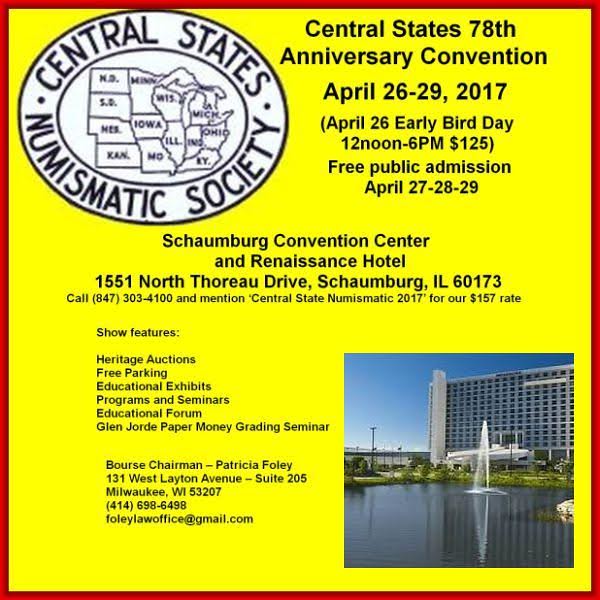
VOCABULARY TERM: CUT COINS
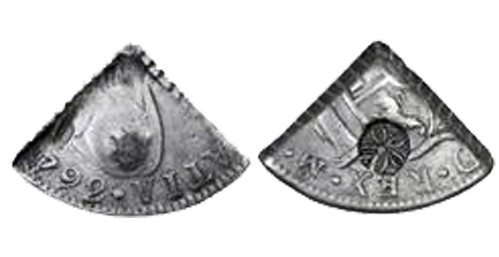
This 2 bit specimen of a cut coin bears counterstamps in addition to being cut in quarters from a Spanish Piece-of-Eight for circulation in Curacao.
Cut Coins. During shortages of small denomination coins, larger coins have been cut into smaller portions to make change for commerce. This was a widespread practice
in the Caribbean Islands in the late 18th century.
CLASS 10.9
ERNEST HAQUETTE (1845-1911)
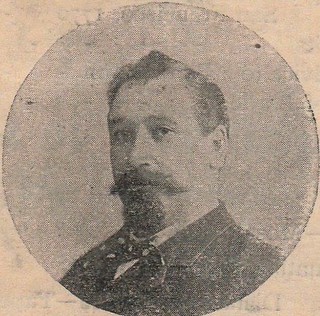 Ernest Haquette (1845-1911), was born in Bouzonville, Moselle, France, on November 11, 1845, son of Pillipe Gerardi Haquette (1818-1866), and Marie Ernesty. His paternal grandfather was
Henri Gerardi Haquette, a member of Napoleon's Old Guard. His parents, consequently, were political refugees during the French empire and emigrated to America in 1851. Eventually they settled in
Chicago in 1855. In 1857 they moved to Saint Louis, Missouri.
Ernest Haquette (1845-1911), was born in Bouzonville, Moselle, France, on November 11, 1845, son of Pillipe Gerardi Haquette (1818-1866), and Marie Ernesty. His paternal grandfather was
Henri Gerardi Haquette, a member of Napoleon's Old Guard. His parents, consequently, were political refugees during the French empire and emigrated to America in 1851. Eventually they settled in
Chicago in 1855. In 1857 they moved to Saint Louis, Missouri.
In 1865 Haquette moved to San Francisco, California, opening a Cafe. His brother Emile J. Haquette moved to Los Angeles, California. He became wealthy in his twenties dealing in the "Silver Rush" in Virginia City, Nevada, in what is known as the Comstock Lode.
In 1875 he became partners with George Hageman in the Crystal Palace Saloon, 5 Kearny Street, San Francisco. The popularity of their saloon may have influenced the naming of the Palace Saloon in Copperopolis, California in 1883. Rulau Ca-Cp2 is the store card of the latter saloon.
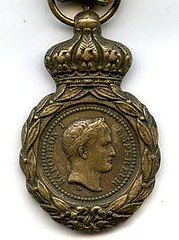
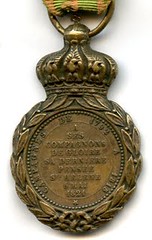
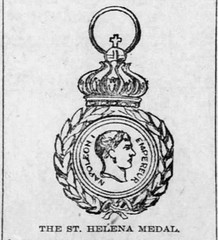
One of the 150 St. Helena Medals struck in 1857, inscribed May 5, 1821, made of gun metal, issued by a decree of Napoleon III in 1857, was given to his father by Napoleon III. His father devised it to Ernest Haquette on his death. In 1895 Ernest Haquette sent the medal to his brother Phillipe "Phil" Gerardi Haquette of St. Louis, Missouri. Phil Haquette willed the medal to his son John Henry Charles Louis Haquette. St. Louis Post Dispatch, Sunday, September 22, 1895, page 27.
After the dissolution of his partnership with Hageman on Friday, October 2, 1896, he continued the Crystal Palace Saloon, as the sole successor at 5 Kearny Street. Sometime about February 1897 Haquette discovered a large amount of counterfeit silver half dollars were circulating at his saloon. He began to give them back to his patrons complaining and developed the reputation of a crank. Fearing loosing his clientele he stopped scrutinizing the coins and accepted them. When the newspapers got wind of it late May 1897 they ran a report suspecting them to have been minted in Mexico. The story ran with the headlines "Silver, And Yet Spurious, An Alarming Increase of Counterfeit Half-Dollars. Government Officials Nonplused." San Francisco Chronicle, Saturday, May 29, 1897, page 9.
Afterwards he opened the Palace of Art at 16 Post Street, San Francisco on April 15, 1900. A public notice was first published announcing the opening in the San Francisco Call, Wednesday, April 12, 1899, page 7. This was a Cafe and Art Gallery that also displayed jewels, gems, and sold coins. He used to exhibit paintings by his cousin Georges Haquette.
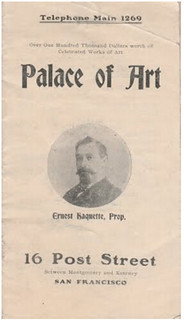
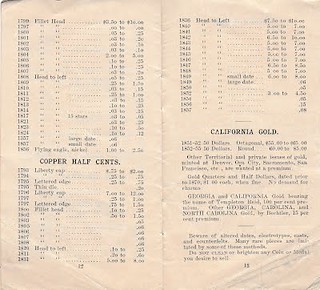
Pages 12-13 of Haquette's Coin Book. Note the warning on California fractional gold pieces stating that, "No demand for charms," and he only sells those prior to 1870. The implication is that from the 1870's on the fractional gold pieces were not considered worth collecting and deemed to be charms or trinkets. A few years later this view was substantiated by Henry Russell Drowne in the American Journal of Numismatics, April (1910), and by Edgar Holmes Adams in both The Numismatist, February (1913), and his book on California Pioneer Gold published that same year.
In 1904, Haquette redesigned his saloon to accommodate women. This, of course, was a bit scandalous for the time and the newspaper reporters gloated on all the exotic curios describing them as both moral and immoral serving as a tease for the women to seek and touch.
On June 24, 1905 he advertised a $500 reward for the return of an 83 carat diamond taken from his Palace of Art. This was most probably the 1869 discovery diamond in Dutch South Africa, called the "Star of South Africa".
On April 18, 1906, Haquette suffered severe losses amounting to $200,000 from the San Francisco earthquake and fire. At the time he had earned $3,000 per month from his Palace of Art. During the fire Haquette paid several men to save the Crocker Home for the Poor next door using his own fire extinguishers, but to no avail. After the fire William Crocker heard of this and gave him $5,000 for his efforts. Hquette was ruined after the fire and could not develop his property at Santa Cruz as originally planned.
On February 20, 1907 Haquette announced his plans to rebuild the Palace of Art. However, in July 1907 Ernest L. Heuter filed suit against him for $12,329 claiming debt from old mortgage of original Palace of Art that was destroyed in the 1906 fire.
m congestive heart failure, on Friday, March 17, 1911, at his home 1647 Post Street, San Francisco. His funeral Mass was held at Notre Dame des Victoires. He was buried at Mount Olivet Cemetery. Though the 1910 Census lists him as a widower he was survived by his wife and daughter Mrs. Louis Frederick Burnette, and his brother Emile J. Haquette. Following his death several newspapers ran colorful accounts of his life since Haquette was a celebrity of San Francisco's social life.
To read the complete article, see:
HAQUETTE, ERNEST
(https://sites.google.com/a/numismaticmall.com/www/numismaticmall-com/haquette-ernest)

EXHIBIT: BELGIAN MEDALLIST GODEFROID DEVREESE
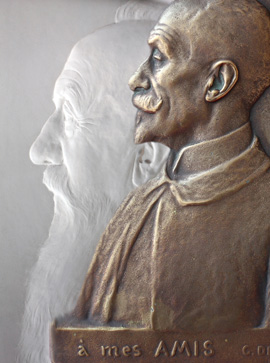
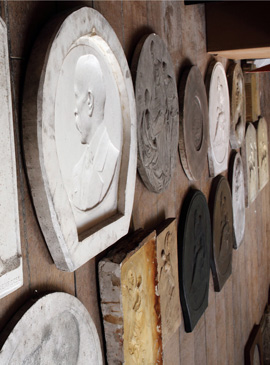
Nicolas Maier writes:
The Maison Losseau in Mons/Belgium (www.maisonlosseau.be) is organizing an exhibition that might be interesting for you and your readers.
The Belgian medallist Godefroid Devreese (1861-1941) and his work are the focus of an exhibition based on the collection of his close friend and art collector Léon Losseau (1869-1949). Over 50 years, Losseau built one of the most impressive medal collections of his time, which contains about 11,000 pieces. The exhibition takes place in the former mansion of Losseau statt, a masterwork of Art Nouveau, and runs from Jan 21 to Apr 02, 2017. It is open Wednesday to Friday 10-18h, Saturday 13-18h, and Sunday 10-17h.
For more information, see:
http://www.maisonlosseau.be/

NUMISMATIC HOLMES FANS TO MEET IN ORLANDO
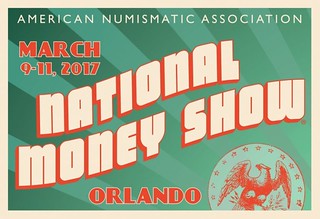 The Fourth Garrideb will be in Orlando, Florida for the American Numismatic Association’s National Money Show being held March 9-11, 2017 at the Orange County Convention Center.
The Fourth Garrideb will be in Orlando, Florida for the American Numismatic Association’s National Money Show being held March 9-11, 2017 at the Orange County Convention Center.
The Numismatic Friends of Sherlock Holmes Dinner will be held at 7P on Friday, March 10, 2017 at Maggiano’s Pointe Orlando, just a few blocks from the Convention Center. Both Sherlockians and Numismatists are invited to attend.
The dinner is purely social – no scholarly papers, no slideshows, no quizzes . . . just toasts. As has become our custom, there will be a souvenir to honor the occasion.
Maggiano’s Pointe Orlando is located at 19101 International Drive, Orlando, Florida 32819. This is just a few blocks (0.6 miles) away from the Orange County Convention Center.
To read the complete article, see:
Numismatic Friends of Sherlock Holmes Dinner to be held March 10 in
Orlando (http://fourthgarrideb.com/2017/02/numismatic-friends-of-sherlock-holmes-dinner-to-be-held-march-10-in-orlando/)
THE BOOK BAZARRE
SELECTIONS FROM DAVISSON'S AUCTION 36
Winter in Minnesota seems to last forever, but Auction 36 is flying by. Catalogs have long since been sent, and we are in the final two weeks of bidding.
Auction 36 closes Wednesday, February 22nd, starting at 10 AM CST (4PM GMT). Make sure to get your bids in before the end!
We have spent all of 2016 selecting our favorite pieces, from consignments and our own holdings, to feature in this sale. Some especially choice examples can still be had at the opening bid. (That includes my personal favorite, the Social War denarius.
Lot 42: Social War Denarius
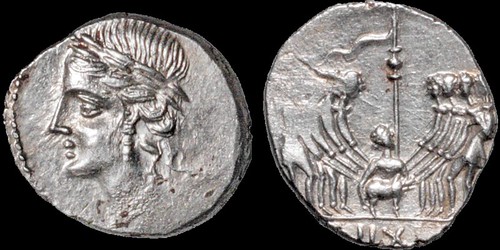
ROMAN REPUBLICAN. The Social War. Marsic Confederation. 90-89 B.C. AR denarius. 3.8 gm. 18 mm. Corfinium mint. Laureate head of Italia left, wearing earring and pearl necklace / Oath-taking scene of eight warriors, four on each side of a pig held by an attendant, a standard in the background; IIX (Oscan control numeral) in exergue. Sydenham 629. HN Italy 415b. Mint State; small area of flat strike on reverse at 9; very lightly toned. Historic, handsome and rare.
The revolt of Rome's Italian allies stemmed from the Senate's poor handling of their grievances. Once war broke out and two Roman consuls were defeated, leaving Rome perilously close to defeat, the Senate finally moved to nullify the threat by granting Roman citizenship to the rebel forces--the key issue at the root of the conflict. Thereafter all residents of Italy south of the Po were united as citizens of Rome. Rome traditionally turned enemies into friends by granting citizenship. The fascinating coinage of the Marsic Confederation consists primarily of silver modeled on the Roman denarius. On the reverse the oath-taking scene symbolizes unity among the Italian states.
To read the complete lot description, see:
Printed Auction 36 Lot 42 ROMAN REPUBLICAN. The Social War. Marsic Confederation
(https://davcoin.com/lot/printed-auction-36-lot-42)
Lot 24: Siculo-Punic Tetradrachm
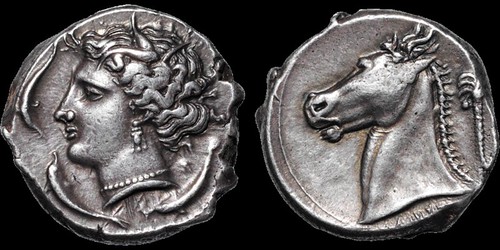
SICULO-PUNIC. 4th Century B.C. AR tetradrachm. 17.16 gm. 25 mm. Head of Persephone-Tanit left, hair wreathed with corn, dolphins around / The head and neck of a horse left, a date palm behind, Punic letters at base of neck. HGC 2, 289 (obverse), 284 (reverse). Jenkins 192 (this coin) Good Very Fine; on a broad flan, attractive old toning. Impressive coin of exquisite style.
Ex Lockett. SNG Lockett 1052 (this coin). Ex Davisson Auction 27, lot 30.
To read the complete lot description, see:
Printed Auction 36 Lot 24 SICULO-PUNIC. 4th Century B.C. AR tetradrachm. (https://davcoin.com/lot/printed-auction-36-lot-24)
Lot 129: Coenwulf Penny
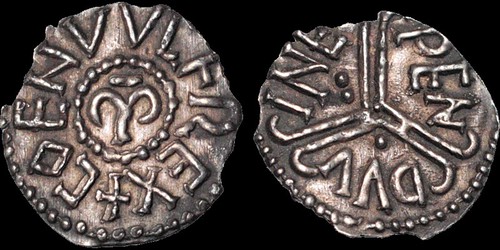
ANGLO-SAXON. Kings of Mercia. Coenwulf. 796-821. AR penny. 1.29 gm. 18 mm. Tribrach type. London. Pendwine, moneuyer. Circa 797/8-805. A Mercian M with a short horizontal line above, a pellet circle around / A tribach moline; PEN | DVV | INE in angles. S. 914. N. 342. Naismith L14a (this coin). Very Fine; rare moneyer.
Ex Delgany Hoard (1874).
Ex Evans (1908).
Ex Lord Grantley (1944).
Ex Blunt, Lyon and Stewart 1963, Coenwulf 17.
Ex SNC XCVIII.6: 4230.
Ex Patrick Finn (1997).
Ex Triton II (1998).
To read the complete lot description, see:
Printed Auction 36 Lot 129 ANGLO-SAXON. Kings of Mercia. Coenwulf. (https://davcoin.com/lot/printed-auction-36-lot-129)
Lot 187: 1694 William and Mary Silver Farthing
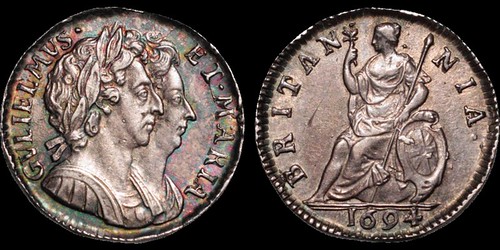
William and Mary. 1689-1694. Silver farthing proof. 4.96 gm. 23 mm. 1694. Their conjoined busts right; GVLIELMVS ET MARIA around (no stop after MARIA) / Britannia seated left; BRITΛNNIA around; 1694 below. S. 3453 type. Peck 627 (R). Good Extremely Fine; choice toning; seldom offered, particularly so fine.
The Frank Robinson Collection
To read the complete lot description, see:
Printed Auction 36 Lot 187 William and Mary. 1689-1694. Silver farthing proof.
(https://davcoin.com/lot/printed-auction-36-lot-187)
Lot 418: 1796 Denton's Collectors' Token
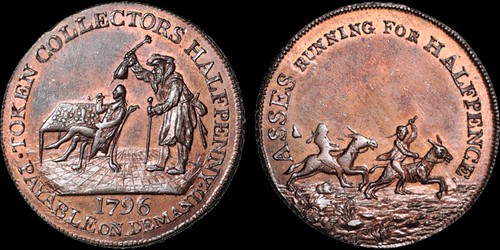
Middlesex 299 (RR). Denton's Collectors' Token. Æ halfpenny. 11.15 gm. 28 mm. 1796. A connoisseur smoking a pipe, sitting at a table spread with medals; behind him an old man is about to place a fool's cap on him; TOKEN COLLECTORS HALFPENNY . PAYABLE ON DEMAND. 1796 / Two boys riding on asses, racing right; ASSES RUNNING FOR HALFPENCE around. Edge: ANY SUM GIVEN FOR SCARCE ORIGINAL IMPRESSIONS. Uncirculated; light toning, surfaces mostly original red. Extremely Rare.
Ex Spink (tag).
To read the complete lot description, see:
Printed Auction 36 Lot 418 Middlesex 299 (RR). Denton's Collectors' Token.
(https://davcoin.com/lot/printed-auction-36-lot-418)
For more information, see:
https://davcoin.com/

'BILLY THE KID' FRACTIONAL CURRENCY NOTE OFFERED
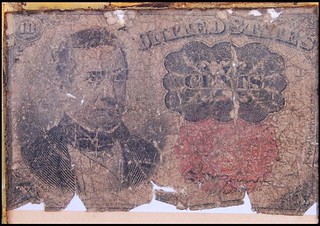 A bank note apparently recovered from the body of Wild West outlaw Billy the Kid is up for sale.
A bank note apparently recovered from the body of Wild West outlaw Billy the Kid is up for sale.
The 10 cent note is going to auction in Bristol next month - 136 years after he was shot.
It was issued between 1874-1876 - at least five years before Billy was shot and killed in New Mexico.
The cash was allegedly found by Ighenio Salazar, a close friend and member of the infamous gunslinger’s posse.
It has now emerged for sale at auction from a Bristol woman who inherited from her late grandfather.
Auctioneers say it remains a mystery as to how the grandfather acquired the bank note.
A contemporary letter that accompanies the currency states it was found by Yginio Salazar, a close friend of Billy the Kid and member of the infamous gunslinger's posse.
It reads:
"Although he had, at various times, stolen stock worth thousands of dollars and made much money in other ways, yet BILLY THE KID had only a few bills of low denomination on his body when he was killed by Sheriff Pat Garrett at Pete Maxwell's house at Whiteoaks New Mexico.
"Here is one of the bills, taken from the body by IGHENIO SALAZAR (sic), before its removal for burial at Fort Sumner."
Andrew Stowe, of East Bristol Auctions, said: "The vendor found it wrapped up very carefully in a drawer in his bedroom while she was clearing out some of his things.
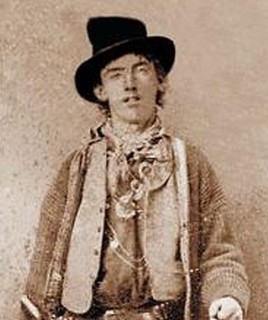 "We have spent six months trying to research the note but like with most things related to Billy the Kid, nothing can really be proven for sure and you are left with best guesses.
"We have spent six months trying to research the note but like with most things related to Billy the Kid, nothing can really be proven for sure and you are left with best guesses.
"So much of the known Billy the Kid history is based on assumption, folklore or hearsay that there are really no facts surrounding his death.
"All I would say is the bank note and note accompanying it are consistent with the date and age and the story in the letter does make sense.
"It is a very difficult item to value. If we valued it too high then people will assume it is real and too low and people will automatically consider it a fake.
"If it is genuine then this could be one of the most significant pieces of Billy the kid memorabilia to ever surface."
The note is being sold on February 24 with a pre-sale estimate of between £200 to £400 but could go for more.
To read the complete article, see:
Banknote found on Billy the Kid's body up for auction - 136 years after his death
(www.mirror.co.uk/news/world-news/banknote-found-billy-kids-body-9804586)
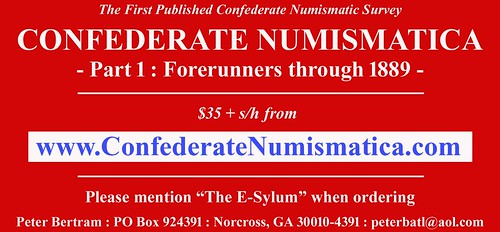
CLEOPATRA'S HAIRSTYLES
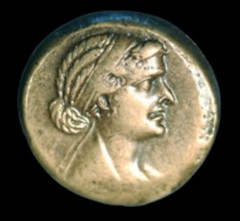
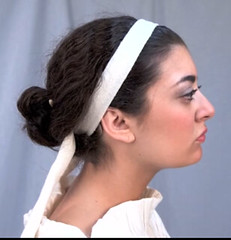
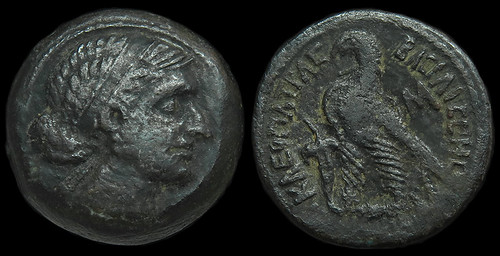
EGYPT, Ptolemaic dynasty. Cleopatra VII Thea Neotera 51-30 BCE AE 40 drachmae; 20 mm, 7.5 gm Obv: Diademed and draped bust right Rev: KΛEOΠATPAΣ BΑΣΙΛΙΣΣHΣ, Diademed and draped bust right / Eagle standing left on thunderbolt; double cornucopiae to left, M (mark of value) to right Ref: Svoronos 1872; Weiser 184-5; SNG Copenhagen 422-4
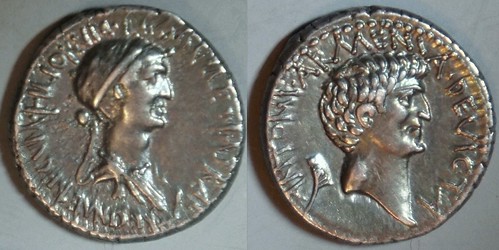
Cleopatra and Tony
To read the CoinTalk thread, see:
Cleo and her hairdo! (www.cointalk.com/threads/cleo-and-her-hairdo.290947/)
To watch the YouTube video, see:
cleopatra's coin hairstyle (https://www.youtube.com/watch?v=Trp9S5AlmeQ)
For reference, here are the person/coin pairings we've seen to date. Thanks to the Grosvenor Museum curators for starting the our conversation with their recent exhibit.
See the next article for more on Hairdressing Archaeologist Janet Stephens, who was in turn inspired by an exhibit of portrait busts at the Walters Art Museum in 2001. -Editor
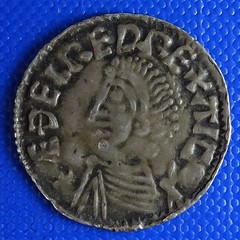
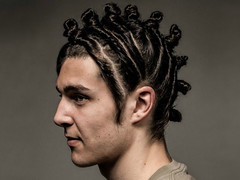

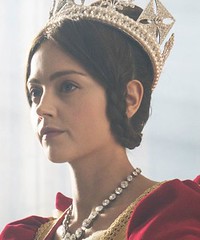
To read the earlier E-Sylum articles, see:
MORE ON HAIRSTYLES FROM COINS AND MEDALS (www.coinbooks.org/v20/esylum_v20n06a29.html)
HAIRDRESSING ARCHAEOLOGIST JANET STEPHENS
Virtually all commentators demonstrate modern technological biases that lead to anachronistic speculation: in both looking at images and interpreting literary passages, they assume that the Romans used the same hairdressing technologies as do moderns. In addition, not being hairdressers, they fail to understand the technical possibilities of the tools that the Romans did have at their disposal. I will analyze the physical capabilities of the single prong hair-pin in order to show the impossibility of its application in many contexts. As an alternative I will propose sewing needles, arguing that, as Roman women of the 1st c. A.D. abandoned vitta-based [(vittae were linen or woollen ribbons used to tie the hair together when arranging it)] coiffures in favor of more elaborate fashions, they used needles (artifacts well attested in antiquity) invisibly to stitch together the style’s various components.
It’s easy to look back on fashions and hairstyles of yesterday and think, “What?” (Or perhaps, more honestly, “Why?”) But one woman is more interested in the “how.” As in: “How did Roman women make their hair look like that?”
Meet Janet Stephens, a hairdresser from Baltimore. Like a superhero of the coiffe, she spends her days as a regular hair dresser, giving people layers and funky bobs. But at home, in her secret hair lair (okay, really just her basement) she attempts to recreate the hairstyles of ancient Rome. Her YouTube channel boasts all sorts of ancient hairstyles, from the Empress Plotina to Cleopatra’s coin hair.
Her first foray into YouTube, published two years ago, recreated the empress Julia Domna’s hair using tools that the Romans would have had.
But Stephens doesn’t just recreate these do’s for YouTube. She also publishes about her research in scientific journals. One paper, called Ancient Roman hairdressing: on (hair)pins and needles, described the difficulties and tools required to recreate Roman hairdos. Many historians had assumed that ancient women depicted with gravity defying curls, bumps and buns were wearing wigs. But, as Stephens told The Wall Street Journal, when she first heard the wig theory, she wasn’t sold:
Through trial and error she found that she could achieve the hairstyle by sewing the braids and bits together, using a needle. She dug deeper into art and fashion history books, looking for references to stitching.
In 2005, she had a breakthrough. Studying translations of Roman literature, Ms. Stephens says, she realized the Latin term “acus” was probably being misunderstood in the context of hairdressing. Acus has several meanings including a “single-prong hairpin” or “needle and thread,” she says. Translators generally went with “hairpin.”
And the journals quickly recognized her expertise. John Humphrey, the editor of the Journal of Roman Archaeology told the Wall Street Journal: ”I could tell even from the first version that it was a very serious piece of experimental archaeology which no scholar who was not a hairdresser—in other words, no scholar—would have been able to write.”
To read the complete article, see:
This Woman Is a Hair-Style Archaeologist
(www.smithsonianmag.com/smart-news/this-woman-is-a-hair-style-archaeologist-82478448/)
Q: How did you first begin to research ancient hairdressing?
 A: My research began with a visit to the Walters Art Museum in 2001. They had just finished renovating the Greek/Roman collections and displayed a number of portrait busts at eye level, out
in the center of the room, like a cocktail party. I had never seen the back of a roman portrait before—they are usually placed high on shelves/pedestal with the backs tight up against a wall. As I
circled the portraits I saw the logic of the hairstyles and determined to try some at home. It was electrifying, can’t thank the Walters enough.
A: My research began with a visit to the Walters Art Museum in 2001. They had just finished renovating the Greek/Roman collections and displayed a number of portrait busts at eye level, out
in the center of the room, like a cocktail party. I had never seen the back of a roman portrait before—they are usually placed high on shelves/pedestal with the backs tight up against a wall. As I
circled the portraits I saw the logic of the hairstyles and determined to try some at home. It was electrifying, can’t thank the Walters enough.
Q: When was the first time you tried to recreate a look and how successful was that initial foray?
A: I think it was my first day off after that visit! I pulled out a long haired mannikin to try out Julia Domna, type 2. I made it as far as the serpentine bun and hit a wall. Bobby pins and hair pins just wouldn’t do the job. It was all library leg work and practical experimentation after that.
Q: Your article in the JRA demonstrates an astonishingly thorough command of the archaeological record, and of primary and secondary sources relating to Roman hairstyling (and not just Roman, but also Etruscan and Greek). How did you master such a density of material?
A: Lots and lots of reading, poring over exhibition catalogs, back searching the footnotes to the reading and reading some more! It helped that I am fluent in Italian and, in 2006, I took a German for reading class. Working in my spare time, the research took 6 years.
Q: Did you do all this research on your own or through a school or other institution or …?
A: I am an independent researcher, but my husband is a professor of Italian at the Johns Hopkins University, so I have library privileges there. We are friendly with colleagues in the Classics/Archaeology department and at the Walters Art Museum. They were kind enough to send me articles and clippings, read drafts and help with some picky Latin, though I try not to impose.
To read the complete article, see:
Janet Stephens: Intrepid Hairdressing Archaeologist (www.thehistoryblog.com/archives/14729)
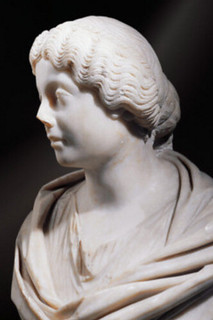 In 2011, Stephens’s friends and husband, an Italian professor at Johns Hopkins, encouraged her to apply for a fellowship to the American Academy in Rome. She didn’t get the fellowship, but
something better happened: She made her first demonstration video and posted it on YouTube. She continued making videos, bypassing the tedious publishing process, still dogged by her first
experimental passion, Julia Domna. She didn’t believe that Julia, or other Roman empresses, wore wigs because of how often their hairstyles changed in portraits.
In 2011, Stephens’s friends and husband, an Italian professor at Johns Hopkins, encouraged her to apply for a fellowship to the American Academy in Rome. She didn’t get the fellowship, but
something better happened: She made her first demonstration video and posted it on YouTube. She continued making videos, bypassing the tedious publishing process, still dogged by her first
experimental passion, Julia Domna. She didn’t believe that Julia, or other Roman empresses, wore wigs because of how often their hairstyles changed in portraits.
Stephens made her hypothesis known at the American Institute of Archaeology’s 2012 annual meeting. She brought with her a crude homemade poster and four mannequin heads on stakes to demonstrate that Julia Domna may have been going bald, not wearing wigs. The academy, schooled again. “I was mobbed,” said Stephens. “I felt like a rock star.”
She had found her groupies. At the same AIA meeting in 2013, she presented a poster on the seni crines, the six-braided and cloth-covered hairstyle of the Vestal Virgins, gaining recognition from The Wall Street Journal. Stephens is the first known person in the modern world to re-create the hairstyle. The corresponding YouTube video has over 101,000 views.
Stephens’s most loyal fans, however, find her not at academic conferences, but in their bedrooms on YouTube. Her discoveries have been a windfall to the ancient Rome-obsessed pockets of the internet. Her dissertation on wigs, for example, brought a much-needed confirmation to online history nerds that experts had been misapplying literary examples to real people for centuries.
To read the complete article, see:
The YouTube Beauty Expert Who Re-creates Ancient Roman Hair
(http://nymag.com/thecut/2015/12/ancient-roman-hair-janet-stephens.html)
To read the earlier E-Sylum articles, see:
MORE ON HAIRSTYLES FROM COINS AND MEDALS (www.coinbooks.org/v20/esylum_v20n06a29.html)
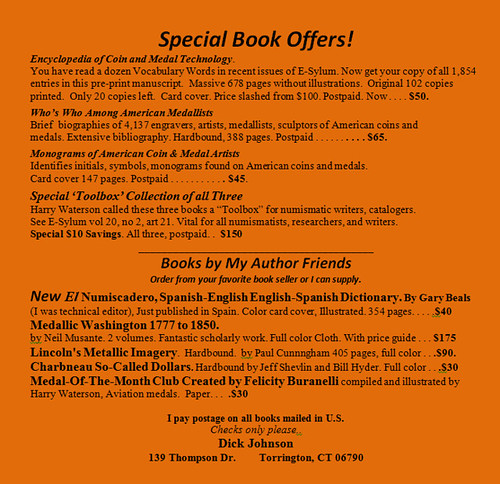
BEARDS OF BYZANTIUM
I have never seen my father's chin. The man has worn a beard since well before I was born, and my brother quickly followed in his tradition. The patrilineal beard is nothing new, however. It is exemplified in much of the Byzantine selection of the National Numismatic Collection. Beards of Byzantium are represented so fantastically in the empire's coinage that they become inseparable from the iconography of the coins—in other words, the beards make the emperor.
Because beards have been such an integral part of my family life, I was impressed with those presented on the coins of Byzantium, the primary focus of my time here with the collection. With so many fantastic follicles at my disposal, I felt it was my duty to follow in the footsteps of the great, and now bearded, David Letterman and create a top list of imperial facial hair.
5. Phocas (Phokas) I, 602–610: The pointiest of the Byzantine beards
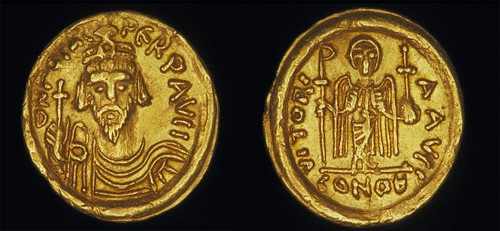
The Byzantine beard really begins with the coinage of Phocas. Sure, Roman emperors before him had some pretty substantial beards (I am particularly fond of Marcus Aurelius's facial hair), but it was under Phocas that beards began to be associated with manhood and even family lineage in Byzantium. His was the first imperial stubble on Byzantine coinage, setting a definite precedent for the jawline of emperors who followed after him
4. Leo III the Isaurian, 717–741: The best groomed of the Byzantine beards
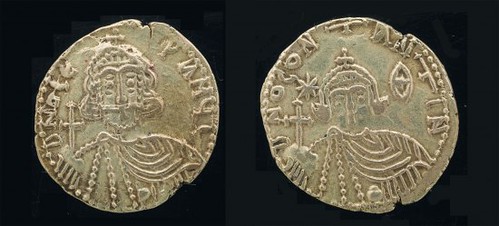
The rule of Leo III shares some significant similarities with the reign of another among the fabulous bearded rulers of Byzantium (see Beard #1). Another similarity is Leo III's serious facial hair. Definitely one of the more controlled chin-coifs, Leo III's beard (and reign) was cool, calm, and collected. With his mustache neatly sculpted, the emperor appears ready for anything—which was good, considering his actions against the Second Arab Siege of Constantinople was necessary immediately after taking over the empire.
3: Christ as depicted in the coinage of Michael III, 842–867: Most illustrious of the Byzantine beards.
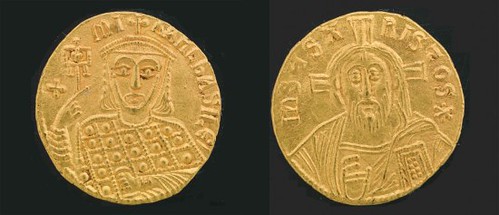
The iconography of Christ in Byzantine art is sublime, and the glory of this robust beard is no exception. Justinian II (of the Heraclian Dynasty) was the first emperor to depict Christ on coinage. While he was not the last to do so, the trend did not take off as he expected. Still, the iconography used to depict Christ is not lacking in his facial hair. This solidus is a gold coin about 23k fine, though gradually debased, that was minted during the reign of Michael III (and Theodora). It portrays Christ with a very notable Byzantine Beard. In fact, his goatee is a rather significant part of the composition and is mimicked in the depiction of Michael III on the back of the coin.
2. Constans II, 641–668: The most ZZ Top-like of the Byzantine beards
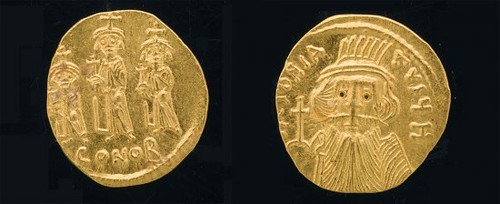
The massive beard of Constans II basically speaks for itself (his contemporary nickname was even Constantine the Bearded) and was in no small way a physical connection to his grandfather Heraclius (see Beard #1!). While the flowing facial locks of Constans II were long and luscious, his reign was not the most comfortable. His ascension to the throne was an event marred by regicide, court intrigue, and deep religious conflict, and the remainder of his reign had little more success.
Honorable Mention: Leontius, 695–698: Just a really good beard
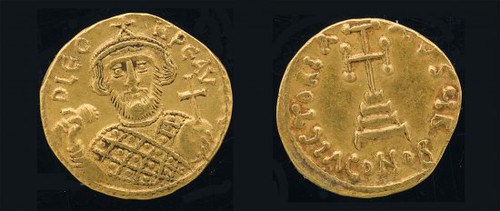
A good beard should never go to waste, and this solidus of Leontius depicts his really decent beard. He rose to power by overthrowing Justinian II (of the Heraclian Dynasty) after several great military successes. However, like his full beard, Leontius' reign was short and jagged.
1. Heraclius (Herakleios), 610–641: The most epic of the Byzantine beards
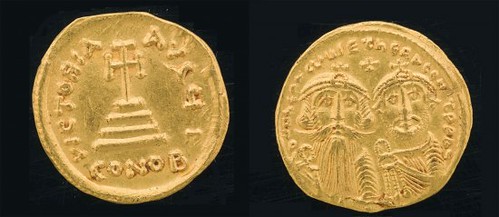
Heraclius's reign was just as big and dramatic as his fabulous facial hair. One of my favorite facets to coins of Heraclius is the development of his beard. As he excels in expansion and rule of Byzantium, his coinage portrays a more robustly bearded iconography—again, the beard really makes the emperor. He reorganized the administration of the empire just as he reorganized the flow of his powerful mustache. He even successfully used his coiffed and powerful beard to regain the True Cross of Christ, previously lost to the Sassanians during the reign of Phocas (see Beard #3). As Heraclius's beard grew more powerful and full on the coinage, his son Constantine III's stubble also developed into some serious five o'clock shadow. Who knew my father and my brother were part of such an illustrious history of wearing large, familial beards?
For even more beards of Byzantium, check back soon to see our online exhibition of Byzantine coins!
Emily Pearce Seigerman is a Museum Specialist with the National Numismatic Collection. She has also blogged about powerful empresses on coins.
To read the complete article, see:
Top 5 best beards of Byzantium (http://americanhistory.si.edu/blog/5-best-beards-byzantium)
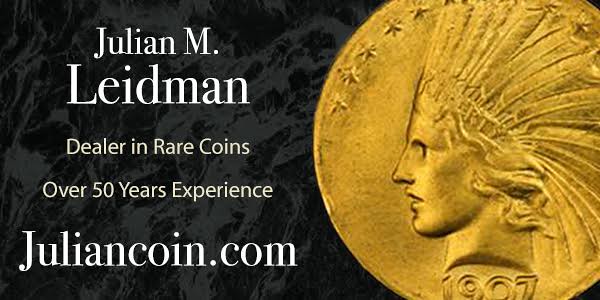
1853 TAIWAN MILITARY RATION LOTUS DOLLAR
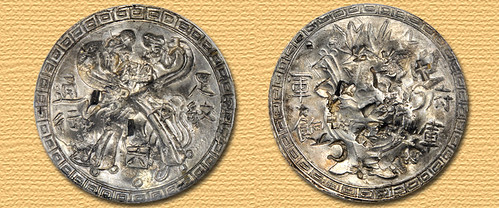
This week our preview for the Stack’s Bowers & Ponterio April Hong Kong Showcase Auction is a very interesting Ration Dollar from Formosa (Modern day Taiwan). The Taiwan Treasury supplied the silver to produce this issue in order to pay for military rations and soldiers. These were issued during several months of uprising in 1853. Struck in the city of Taiwan, once the uprising was put to an end, minting of this coinage ceased.
The obverse design features two crossed Lotus flowers, which lend the type its colloquial name: “Lotus Dollar.” Two Chinese characters at the right side of the Lotus flowers denote: “Pure Pattern,” while at the left side two characters mean: “For General Circulation.” The reverse depicts a vase containing a plant. The Chinese characters that surround the vase translate to “Prefectural Treasury” and “Military Rations.”
This type is normally found with a multitude of chopmarks, which can be found on the obverse and reverse of this example, though less so on the obverse. A decorative Greek border surrounds both designs. Despite the chopmarks, this example hosts some lovely golden toning hidden with the recesses, which is slightly more vibrant on the reverse.
To read the complete article, see:
High Grade Ju-I Military Ration Lotus Dollar (www.stacksbowers.com/News/Pages/Blogs.aspx?ArticleID=2417)
DIX NOONAN WEBB SELLING SANDERS WWI MEDALS
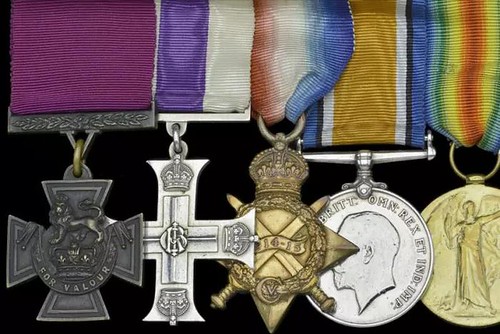
The decorations and medals awarded to George Sanders. From left to right: Victoria Cross, Military Cross, 1914-15 Star, British War Medal
HE was a Holbeck lad and War hero, who won a Victoria Cross for his extraordinary courage on the first day of the Battle of the Somme.
Now the VC, awarded to George Sanders, for fighting off German attacks for 36 hours, despite being hugely outnumbered, is going under the hammer.
With his Military Cross, which he won later in the war, and other medals, the collection could fetch up to £220,000 at an auction in London on March 1.
At Leeds Minster last year, the focus was on Corporal Sanders, as the nation fell silent to to honour thousands of soldiers killed in the Battle of the Somme 100 years after the bloodiest day in British military history.
Cpl Sanders, who enlisted in the Leeds Rifles, took charge of an isolated group of men cut off as the British offensive ground to a halt. Impressing on them it was “his and their duty to hold the position at all costs” they fought desperate actions, all without food and water, returning to British lines with 19 of his comrades.
“It was astonishing gallantry from a young corporal who had been in the Army for just over 18 months,” said Pierce Noonan, director of auction house Dix, Noonan Webb.
To read the complete article, see:
Leeds Somme hero’s medals go under hammer
(www.yorkshireeveningpost.co.uk/news/leeds-somme-hero-s-medals-go-under-hammer-1-8381246)
HERITAGE OFFERS OLGA KORBUT'S OLYMPIC MEDALS
One of the most celebrated athletes in Olympic history, former Soviet gymnast Olga Korbut, now 61, has personally consigned to Heritage Auctions’ Feb. 25 and 26 sale her complete collection of Olympic medals and memorabilia.
The consignment includes, combined, three gold medals and two silver medals that she won in the 1972 Summer Olympic Games in Munich and the 1976 Summer Games in Montreal, along with medals and related items from before and after her Olympic performances.
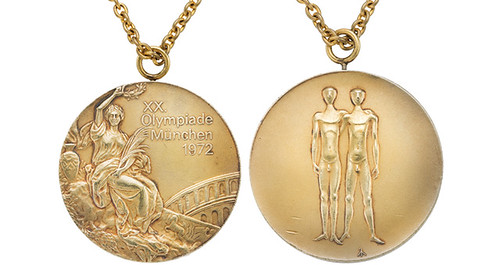
1972 Munich Floor Exercise gold medal
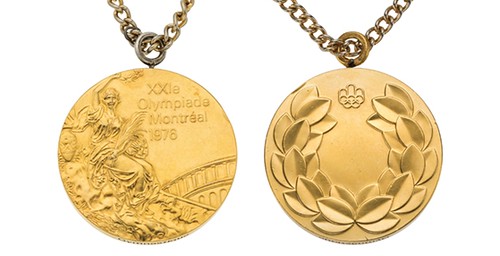
1976 Montreal Gymnastics gold Medal
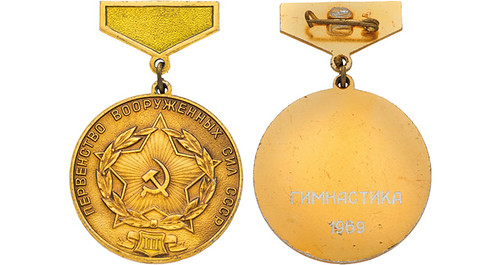
1969 Army of the USSR gymnastics competition medal
To read the complete article, see:
Olga Korbut parting with awards for Olympic performances that brought worldwide
recognition (www.coinworld.com/news/us-coins/2017/02/olga-korbut-olympic-medals-in-heritage-auctions-stage.html)
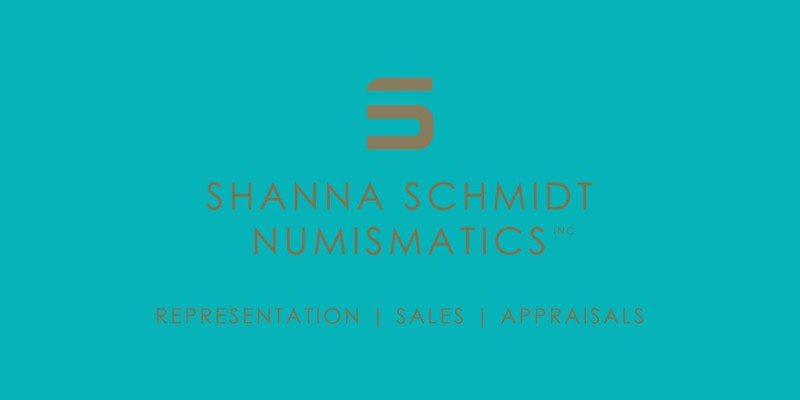
DICK JOHNSON: SO WHERE'S THE INAUGURAL MEDAL?
I have written a letter chastising Senator Roy Blunt for not issuing a Donald Trump Inaugural Medal. He may not deserve the full blame but he was in charge as chairman of the Inaugural Committee, therefore he must take the arrows. Here’s what I wrote:
Senator Roy Blunt, Chairman
Congressional Committee on Inaugural Ceremonies
260 Russell Senate Office Building
Washington, DC 20510
Dear Senator Blunt:
Where is the official Donald Trump Inaugural Medal? The Inaugural Medal issued by the Ohio Republicans falls woefully short of being the medal issued and endorsed by the Inaugural Committee and having full official status.
For 119 years it has been the modern custom to issue a fine art medal for the incoming president, bearing his portrait, a custom extending back to President McKinley. Issuing a medal for the new president is similar to the same practice of issuing a medal for a new king in a sovereign nation, a heritage extending back more than 500 years.
You have abrogated this custom, this American heritage by not having the medal available prior to the inauguration.
At the luncheon following the swearing-in ceremonies, you displayed several souvenirs to the audience. On the streets there were vendors selling more ephemeral souvenirs. While the Inaugural Medal may be considered a souvenir, it rises above all others. Medals are created by America’s most notable sculptors, in essence a miniature work of art. Medals have a longevity greater than most of mankind’s creations. They exist for centuries.
How unfortunate Donald Trump was not given this honor.
I direct your attention to a book, The President’s Medal 1789-1977. This book was written by Neil MacNeil, considered the greatest scholar on the United States Senate. He was an author, and Time Magazine’s Chief Congressional Correspondent for 30 years. In his book he traced the Inaugural Medal back to George Washington, providing a 211-year heritage of American President’s Inaugural Medals.
Inaugural medals are produced at no cost to the American taxpayer, they are underwritten entirely by private industry. Their sale to the public is augmented by sale to medal collectors. Profits from these sales are shared with the Inaugural Committee. I admit I am one of these buyers.
The Inauguration Ceremonies this year held a fascination for me. You are to be congratulated for its success. However I was disappointed not to learn of a Trump Medal and obtain one of these.
I hold quite dear the two occasions I attended such a ceremony. I cherish the two Presidential Inaugural Medals of these two Presidents. They bring back fond memories, despite my position among the masses of viewers.
Kind Sir, I believe you owe an apology to the American public and perhaps to the collectors of Inaugural Medals for your oversight of this most important event documenting the Inauguration of our new President
Most Respectfully,
Dick Johnson, Medal Collector
To read the earlier E-Sylum articles, see:
NO OFFICIAL INAUGURAL MEDAL FOR TRUMP (www.coinbooks.org/v20/esylum_v20n03a13.html)
MEDALCRAFT MINT TO PRODUCE TRUMP INAUGURAL MEDAL (www.coinbooks.org/v20/esylum_v20n04a25.html)
OHIO REPUBLICAN PARTY OFFERS TRUMP MEDAL (www.coinbooks.org/v20/esylum_v20n06a27.html)
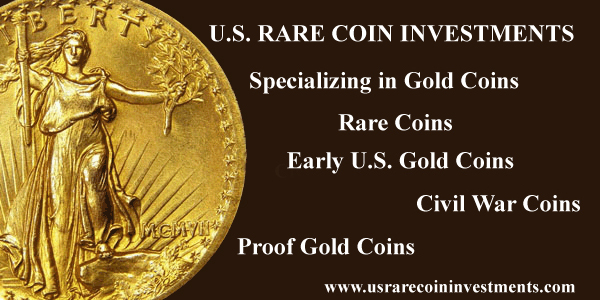
EFFIGY MOUNDS QUARTER LAUNCHED IN IOWA
The U.S. Mint's launch ceremonies for new coin designs are great events, and as a numismatist I can't help but imagine what it would be like to go back in time and attend such a gathering when one of the iconic coins of the 19th or 20th centuries were first released to the public. Such releases rarely had such fanfare, but how cool would it have been to have the coin designers and mint officials on hand to meet in person?
I enjoy reading local coverage of these events, but had to dig deep in Google News results to find a report from the latest venue in eastern Iowa where the Effigy Mounds quarters were released. Most of the coverage out there is from numismatic publications repurposing the Mint's press release. Here's a lengthy excerpt from a report from local media station KWWL, with images from their video report, which can be seen online in its entirety. -Editor
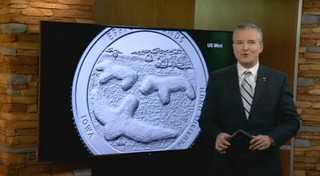 The newest quarter in the "America the Beautiful" series, depicting a popular Eastern Iowa national monument, is officially in circulation.
The newest quarter in the "America the Beautiful" series, depicting a popular Eastern Iowa national monument, is officially in circulation.
The quarter, featuring Effigy Mounds National Monument, officially launched Tuesday to a crowd of more than 1,000 in Waukon.
A number of fourth graders from the Allamakee School District received a quarter right away, and instantly giving it rave reviews.
Two of them said it was really cool to see Effigy Mounds on a quarter.
Senior Mason Hermeier agreed.

"It's super cool, because I've grown up having Effigy Mounds be a part of my life, and I never expected to see it on a quarter. So it's very cool to see it actually in action, at our school, getting presented," she said.
The ceremony honored the Native American heritage and history behind the famous mounds.
Astronaut and Iowa native Peggy Whitson also sent a video message from the International Space Station.
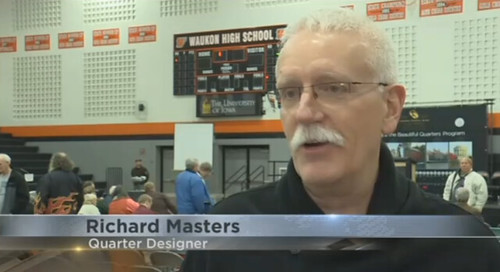
The quarter's designer, Richard Masters, was also on hand for the launch.
Masters is an Iowa native and requested this specific job.
He says capturing the iconic mounds on a quarter is easier said than done.
"It was a challenge, because these are earthen mounds that are barely visible from the ground, and I had to conceive of an interesting idea that would look good on a quarter, which is only about an inch in diameter," he said.
Many who work in the park or are familiar with it say they're thrilled to see mounds on the quarter that so closely mirror what you'll find in the park.
Those quarters are available for exchange in rolls only at all Kerndt Brothers Bank locations.
To read the complete article, see:
Effigy Mounds quarter officially launches
(www.kwwl.com/story/34453147/2017/02/Wednesday/effigy-mounds-quarter-officially-launches)
While I'm usually critical of flat coin designs in this case it's warranted by the nature of the subject matter, and designer Richard Masters deserves credit for the perspective view he created. it's a nice coin, and serves its purpose well.
Here are some additional images from the U.S. Mint press release. -Editor
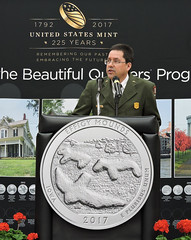
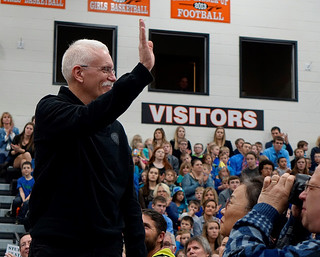
Left: Effigy Mounds National Monument Superintendent Jim Nepstad
Right: Designer Richard Masters
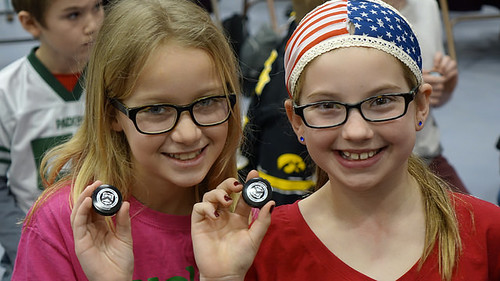
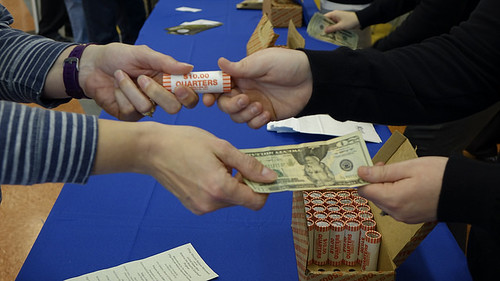

POLAND ISSUES NEW 500 ZLOTY BANKNOTE
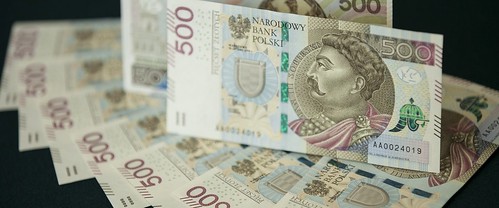
A new PLN 500 banknote will enter circulation in Poland on 10 February, the country’s central bank has said. The new bill is a response to market demand and the rising costs of maintaining the central bank’s strategic reserves, according to the National Bank of Poland (NBP).
The note will feature an image of King Jan III Sobieski, who reigned from 1674 to 1696, to preserve the chronological continuity of the “Polish Rulers” series, the bank said.
The bank started working on the new note in November 2014.
Designed by Andrzej Heidrich and initiated in 1995, the “Polish Rulers” series includes Mieszko I (who ruled from c. 960 to 992 and is featured on the PLN 10 note), Boleslaus I the Brave (992-1025; PLN 20), Casimir III the Great (1333-1370; PLN 50), Ladislaus II Jagiełło (1386-1434; PLN 100), and Sigismund I (1506-1548; PLN 200).
All the notes are produced for the NBP by the Polish Security Printing Works in Warsaw.
To read the complete article, see:
A new PLN 500 banknote will enter circulation in Poland on 10 February, the country’s central bank
has said. (http://poland.pl/economy/investments-projects/new-polish-pln-500-note-enter-circulation/)
Going against a global trend of discouraging cash use, the European Union's biggest eastern economy Poland launched a new 500-zloty ($123.82) banknote on Friday to reduce the cost of storing reserves and better reflect rising levels of affluence.
The central bank took the decision despite a request from a deputy economy minister to reconsider on grounds the new banknotes could facilitate criminal activity and make it more difficult to fight the grey economy.
"It is clear that there is a need to supplement the structure of banknotes in circulation," central bank board member Jacek Bartkiewicz told reporters. "The need for cash is rising."
Thanks to its robust economic growth and despite over two years of deflation that ended last year, Poland has seen a steep rise in cash used, with the value of currency in circulation rising by 15 percent last year alone.
Bartkiewicz said the new banknote will be available to the general public, though he did not expect it to be widely used in day-to-day transactions.
He said the banknote would make it cheaper for the central bank to keep and produce its strategic cash reserve.
Poland's new 500 zloty banknote will be worth approximately the same as the highest denomination note in Denmark, Norway - two countries actively promoting electronic money - and Romania, but still considerably less than in the Czech Republic, Belarus or in the euro zone.
To read the complete article, see:
Bucking global trend, Poland launches 500 zloty banknote
(http://finance.yahoo.com/news/bucking-global-trend-poland-launches-121054299.html)
THE BOOK BAZARRE
SO WHY DO PEOPLE WRITE CHECKS FOR GROCERIES?
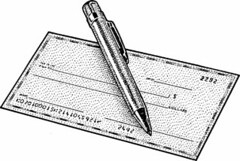 When Gert Watkins pulls out a check at Wal-Mart or Target, the shoppers in line behind her roll their eyes, sigh deeply and mutter under their breath.
When Gert Watkins pulls out a check at Wal-Mart or Target, the shoppers in line behind her roll their eyes, sigh deeply and mutter under their breath.
Ms. Watkins, a 67-year-old former banker in Birmingham, Ala., knows that many other shoppers pay with credit cards and debit cards, but she doesn’t care.
“They make those faces, but I just turn around and say ‘I will be through shortly, sweetie. It’s my turn now,’ ” she says.
Check-writing may be dying, but it isn’t dead yet. A sliver of consumers still clings to paper and pen, forgoing the ease of plastic for the rigor of balancing their checkbooks every month.
Such behavior is bewildering to more modern consumers brandishing payment apps and chip cards, some of whom don’t even know how to write a check. To other shoppers, check-writers are the scourge of the check-out line.
Michael Moeser was shopping at a Target in California on Black Friday a few years ago when a shopper ahead of him pulled out a check. In a matter of moments, other shoppers in line behind him scurried to other lanes.
“It was like a leper from the lepers’ colony showed up,” said Mr. Moeser, who works at a consulting firm tracking the payments industry.
For check-writers, recording the payment in a checkbook while standing in line is a sign of good financial hygiene. Everyone else says the behavior is as curious as buying a savings bond at the local bank branch or receiving a passbook when opening a savings account.
The practice of writing a check in a store is particularly mystifying to millennials, many of whom zap money to each other electronically through PayPal’s Venmo, Facebook or Snapchat.
People who pay by check in stores say it gives them a greater feeling of security than using plastic and it is more convenient than carrying a wad of cash. They also say they feel more in control of their spending.
“I just feel safer,” says Bill Aber, a former chef who lives in Jersey City, N.J., and has been the victim of credit-card fraud.
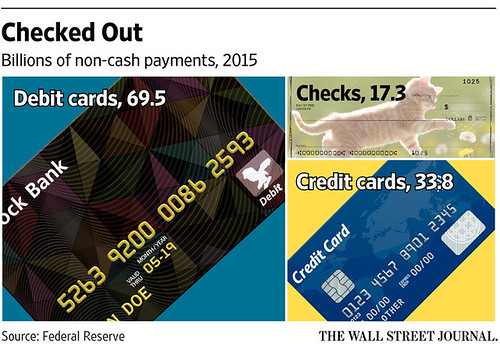
Despite the relentless march of credit cards, debit cards and mobile payments, Americans wrote 17.3 billion checks in 2015, according to a survey released by the Federal Reserve last month. That compares with the 41.9 billion checks written in 2000 when the Fed started conducting the survey, which it does every three years.
While check payments fell at an annual rate of 4.4% between 2012 and 2015, the drop represented a slowdown in the rate of descent for the first time.
Deluxe Corp., the big check-printing company, has tried to persuade shoppers that checks are worth using. The company launched a check-writing push in 2010 that featured a video starring “Duncan Steele—The Man with Checks Appeal” who writes a check to pay for a 59-cent stick of beef jerky in a convenience store.
“Credit cards are a sucker’s game,” he says with a wink to the annoyed people waiting in line behind him. By the video’s end, the woman behind him stops rolling her eyes and leaps into his arms.
Um, yeah. That happens all the time.
I've already confessed to being "that old guy who holds up the line with exact change". I just don't want to micromanage my small purchases with a zillion tiny transactions on my credit or debit cards. Not that I'm trying to hide how many donuts I've bought at 7-11 (see, they're right here on my butt). A few larger cash withdrawals help me manage the monthly cash flow. But everyone manages their funds differently - as the article shows, ask five different people and you'll hear five different money management styles and strategies. It's at least partly generational, and in time maybe even the cash-paying dinosaurs like me will be extinct.
But I've never seen the logic of writing checks for groceries. Keep your checkbook handy if you're running on fumes and need to know to the penny how much you have available. But use a debit card and speed through the line.
I love how the illustration is captioned "A personal check" for the benefit of readers who may never have seen or heard of one. It's like explaining to my kids what an ashtray or gas station attendant was. -Editor
To read the complete article (subscription required), see:
Go Ahead, Write a Check for Your Coffee, I’ve Got All Day
(www.wsj.com/articles/go-ahead-write-a-check-for-your-coffee-ive-got-all-day-1485277398)
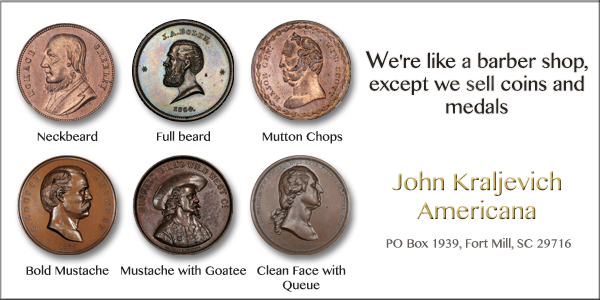
FEATURED WEB PAGE: THE US BANKING SYSTEM
This week's Featured Web Page is an article on the history of the U.S. banking system by Richard Sylla, Chairman of the Board of the Museum of American Finance.Banks are among the oldest businesses in American history—the Bank of New York, for example, was founded in 1784, and as the recently renamed Bank of New York Mellon it had its 225th anniversary in 2009. The banking system is one of the oldest, largest, and most important of our industries. Most adult Americans deal with banks, often on a fairly regular basis. Nonetheless, banks and banking seem rather mysterious. What do banks do? Why have they for so long been an integral part of our economy?
Banks have two important economic functions. First, they operate a payments system, and a modern economy cannot function well without an efficient payments system. We make most of our payments by writing checks, swiping credit cards issued by banks or tied to them, and by paying bills via online banking. Most of the money stock of the country is in fact bank money; the rest of the currency is “legal tender” issued by the government, namely Federal Reserve Notes and coins. We have confidence in bank money because we can exchange it at the bank or an ATM for legal tender. Banks are obligated to hold reserves of legal tender to make these exchanges when we request them.
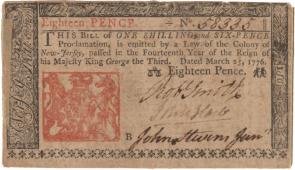
/www.gilderlehrman.org/history-by-era/hamiltoneconomics/essays/
us-banking-system-origin-development-and-regulation



